Minor in Biology
In the biology as minor subject curriculum, we offer the teaching module "Biodiversity of Plants", with lectures on Lecture2Go in the winter semester and practical courses in the summer semester.
Please note: all our teaching sessions for biology as minor are in German.
Biodiversity of Plants
- Contact: Jens G. Rohwer( Jens.Rohwer"AT"uni-hamburg.de)
- Target groups: BA / BSc students in education, 3rd and 4th semester; students with biology as minor subject
61-710 Synopsis of the Plant Kingdom (lecture)
Dieter Hanelt, Jens G. Rohwer
We present an overview of the most important groups of organisms that are tradionally the subject of botany (i.e., more than just "plants"): cyanobakteria ("blue-green algae"), the most important groups of algae, mosses, liverworts, ferns and other pteridophytes, gymnosperms and angiosperms, as well as the most important groups of fungi, including lichens. The basic questions answered are:
- Which are the most important evolutionary lineages?
- How can they be recognized?
- What are the stages of their reproductive cycles?
- What are the scientific terms for their most important structures?
- In which way are they related?
- What makes one group more successful than another?
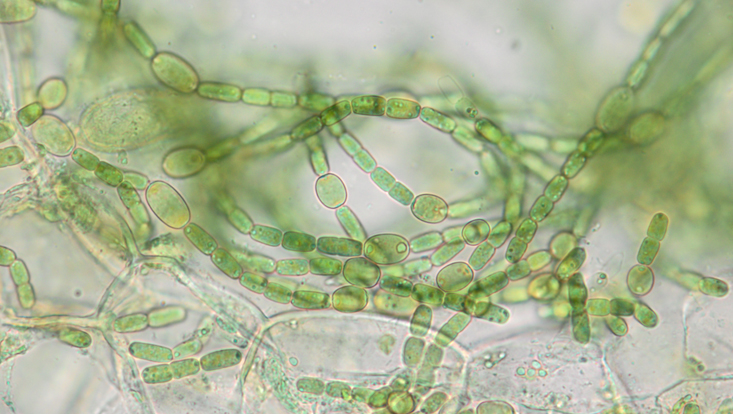
Photo: UHH/Rohwer
Light microscope photo of the cyanobacterium Anabaena azollae, with heterocytes
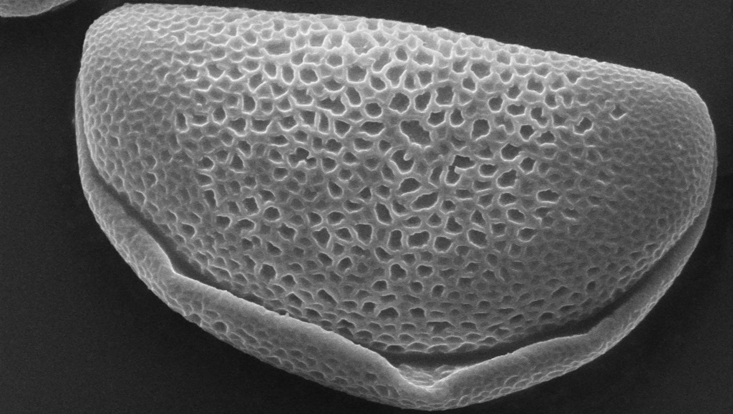
Photo: UHH/Rohwer
Scanning electron microscope photo of a pollen grain of Clivia
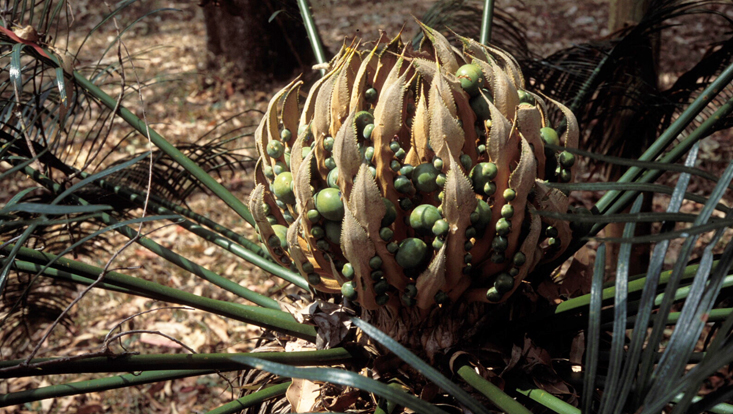
Photo: UHH/Rohwer
Tip of a stem of Cycas circinalis, with megasporophylls
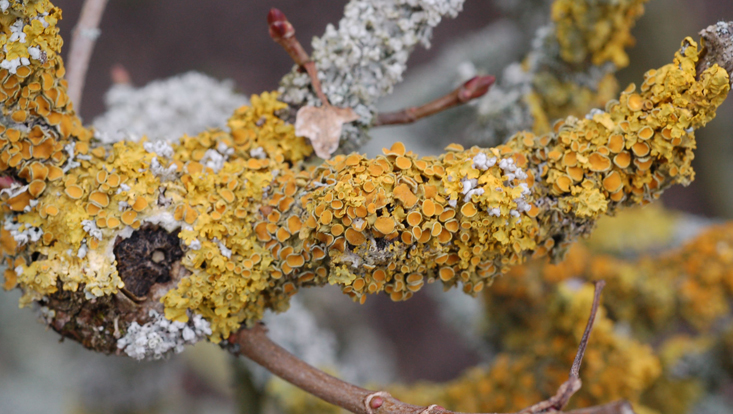
Photo: UHH/Rohwer
One of the most common native lichens, Xanthoria parietina, with apothecia
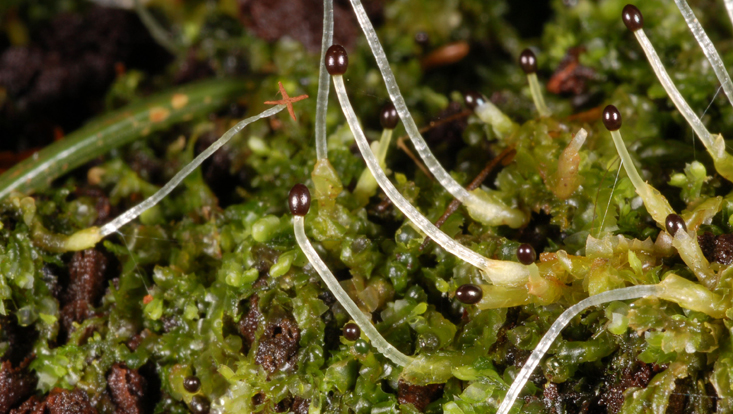
Photo: UHH/Rohwer
Foliose liverwort Lophocolea heterophylla with sporogones
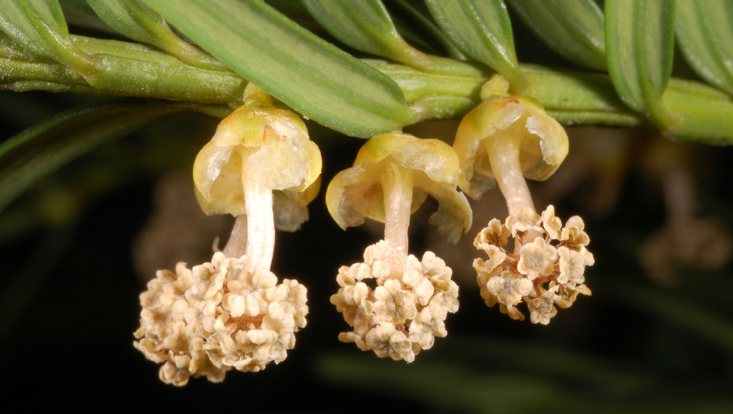
Photo: UHH/Rohwer
Branch of the common yew (Taxus baccata) with microsporangiate (= male) cones
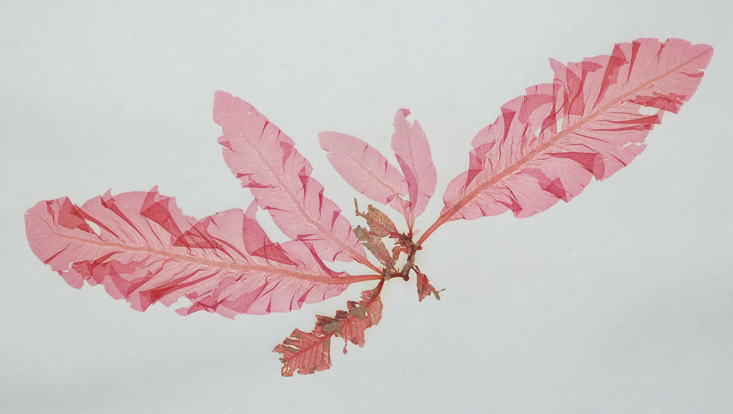
Photo: UHH/Rohwer
Red alga, Delesseria sanguinea, Rhodophyta
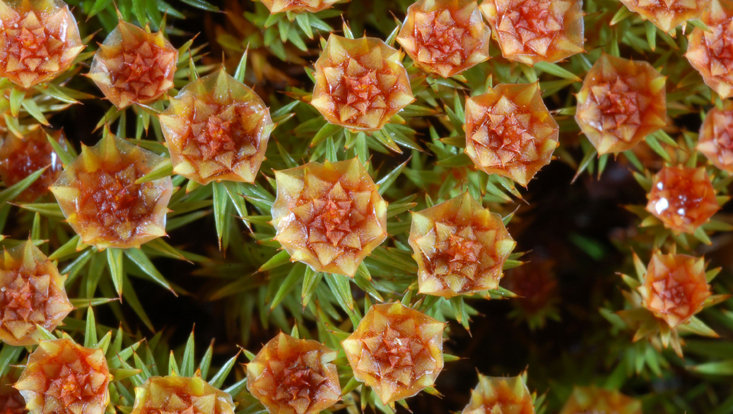
Photo: UHH/Rohwer
Antheridial heads of Polytrichum
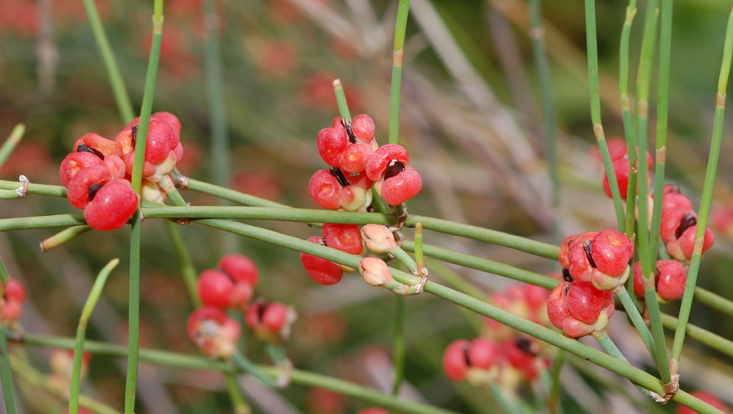
Photo: UHH/Rohwer
Branches of Ephedra distachya with seed between fleshy scales
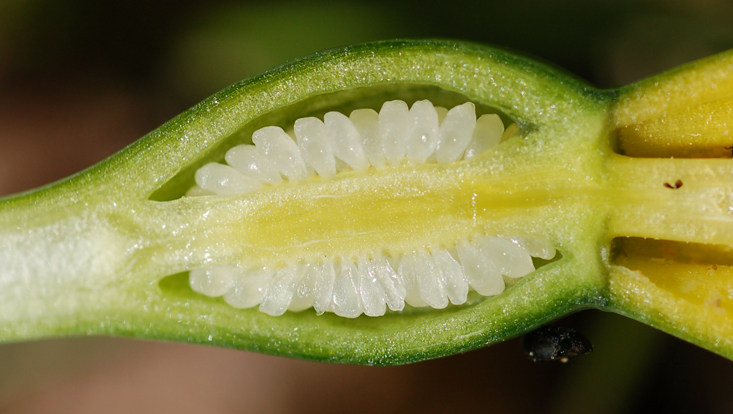
Photo: UHH/Rohwer
Ovary of Narcissus pseudonarcissus, longitudinal section, showing numerous ovules
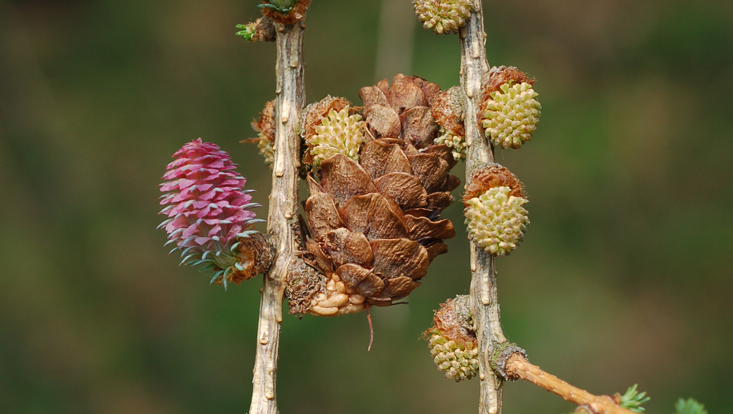
Photo: UHH/Rohwer
Branches with cones of European larch (Larix decidua); pollen cones yellow, ovulate cone red, mature seed cone brown
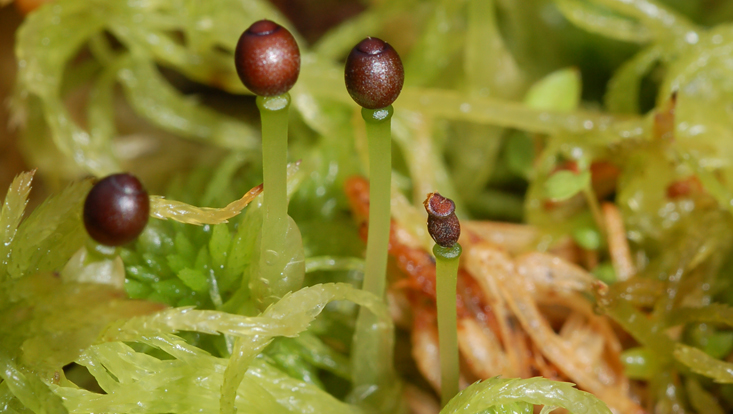
Photo: UHH/Rohwer
Peat moss (Sphagnum spec.) with sporogones
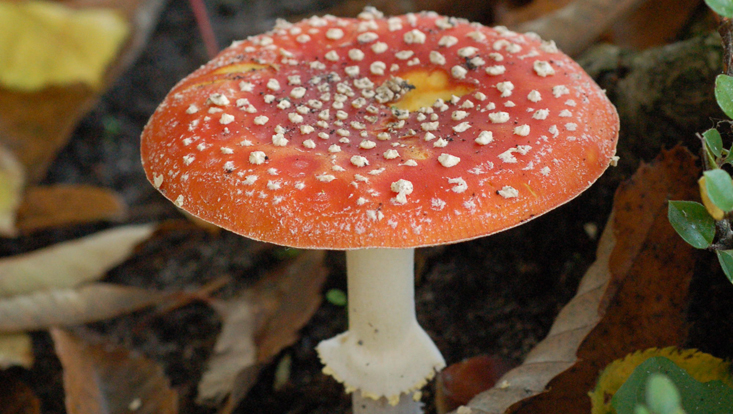
Photo: UHH/Rohwer
Fruiting body of the fly agaric (Amanita muscaria, Basidiomycetes)
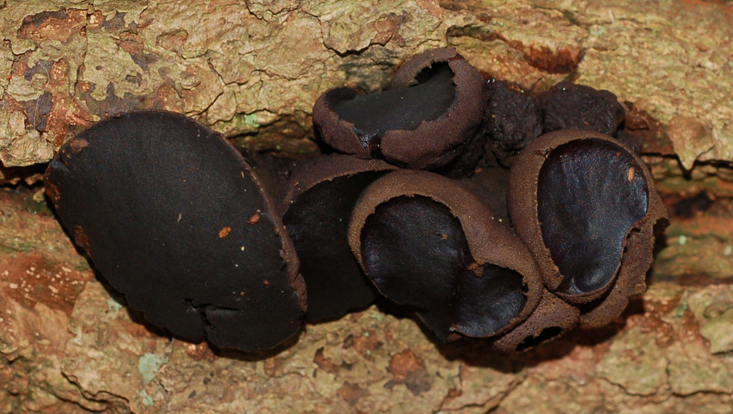
Photo: UHH/Rohwer
Fruiting bodies (apothecia) of the Black Bulgar (Bulgaria inquinans, Ascomycetes)
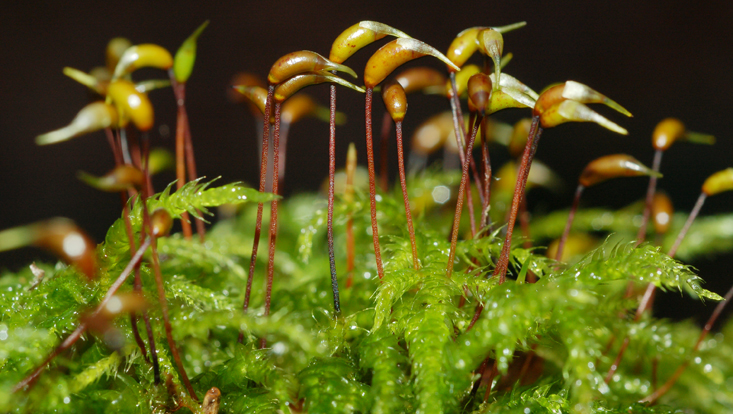
Photo: UHH/Rohwer
Moss with sporogones
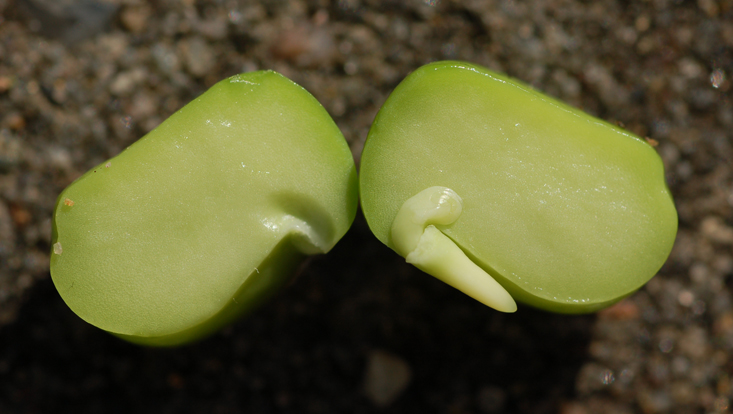
Photo: UHH/Rohwer
Embryo of a pea (Pisum sativum), one cotyledon separated, plumule (shoot bud) and radicle (initiation of primary root) clearly visible
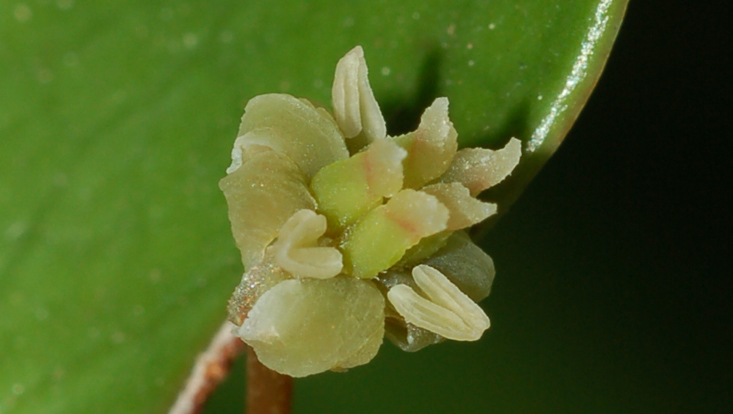
Photo: UHH/Rohwer
Flower of Amborella trichopoda, sister group of all other angiosperms (often addressed as 'the most primitive living angiosperm')
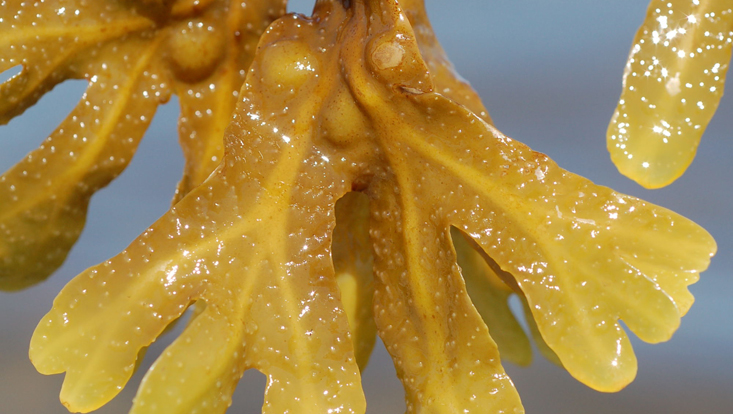
Photo: UHH/Rohwer
Bladderwrack, Fucus vesiculosus (brown algae, Phaeophyceae)
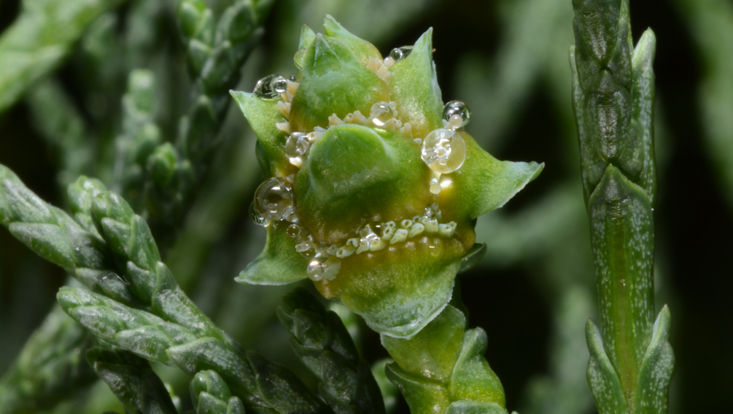
Photo: UHH/Rohwer
Ovulate cone of a cypress (Cupressus), with pollination droplets on tubular micropyles
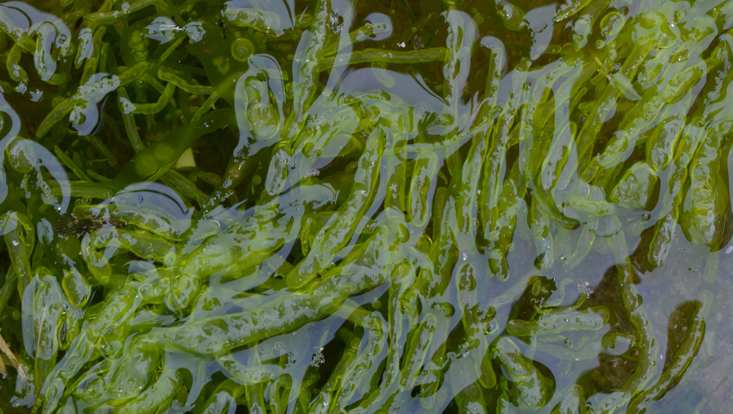
Photo: UHH/Rohwer
Green alga Ulva intestinalis
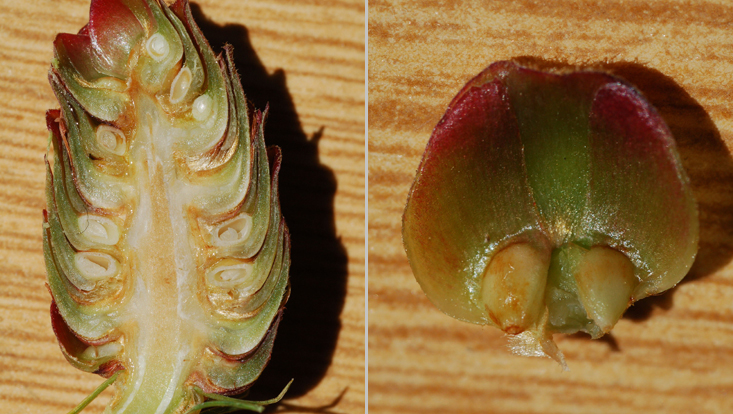
Photo: UHH/Rohwer
Immature cone of Larix decidua: longitudinal section (left); seed scale with two developing seeds (right)
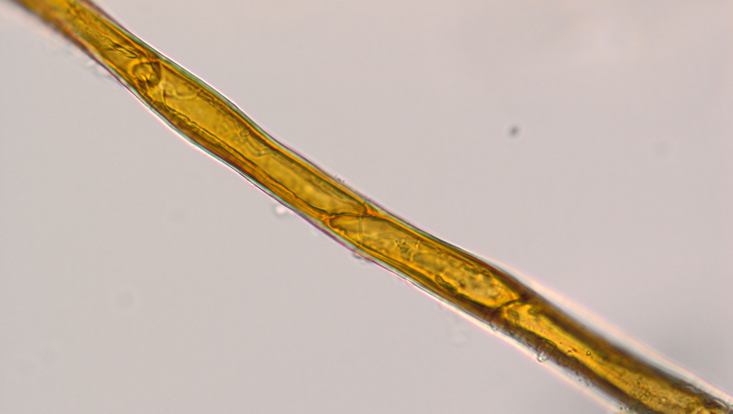
Photo: UHH/Rohwer
Light microscope photo of a moss rhizoid
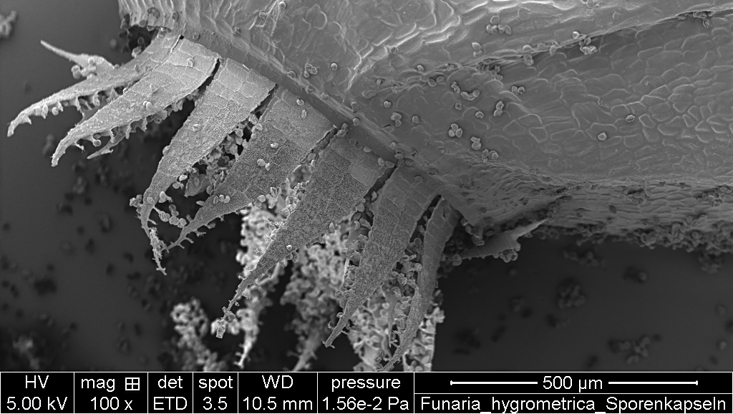
Photo: UHH/Rohwer
Scanning electron microscope photo of the peristome of Funaria hygrometrica
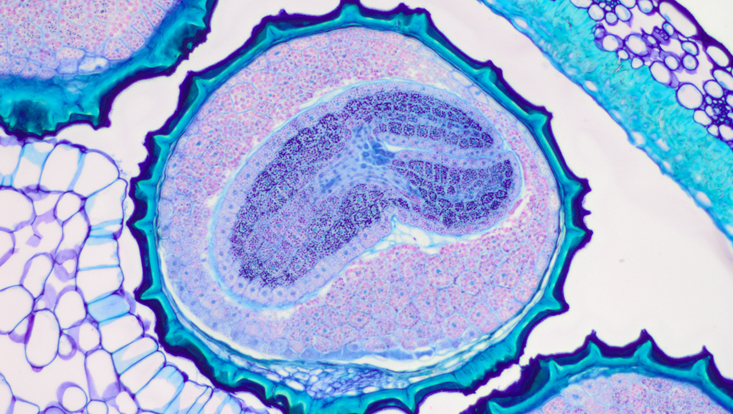
Photo: UHH/Rohwer
Light microscope photo of a section of a seed of Petunia axillaris; pericarp visible in the upper right hand corner, placenta in the lower right hand corner
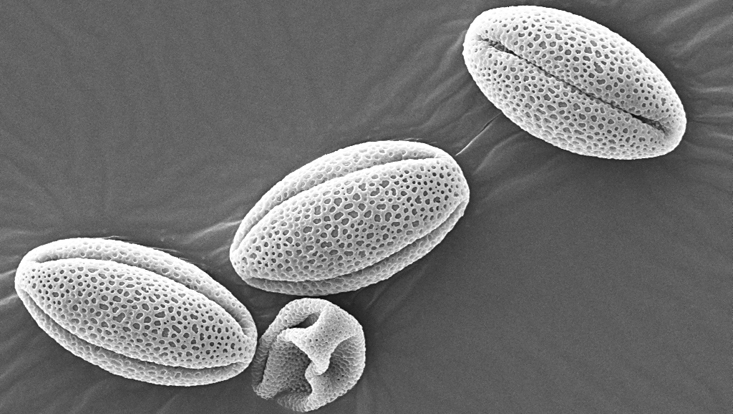
Photo: UHH/Rohwer
Scanning electron microscope photo of Streptocarpus pollen grains
61-034 Morphology and Systematics of Native Vascular Plants (lecture)
Jens G. Rohwer
This lecture explains the fundamentals necessary to become familiar with the native flora. Topics include:
- The most important structures of flowering plants
- Terminology for description and determination of plants
- The most important native plant families and how to recognize them
- The most important crop plants from these groups
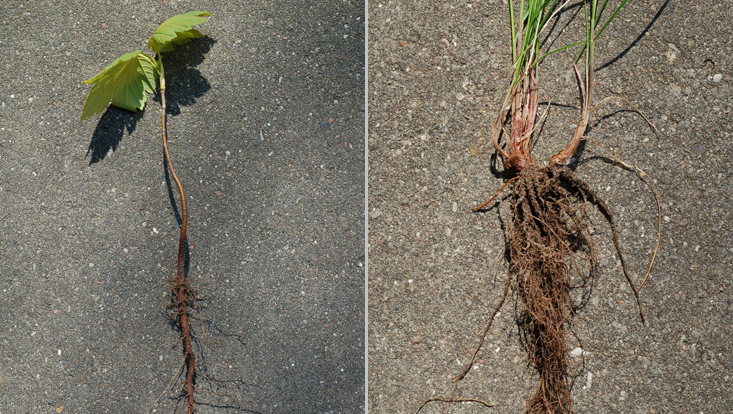
Photo: UHH/Rohwer
Root systems: allorhizal = with a primary root and secondary roots (left) and homorhizal = with more or less equal roots (right)
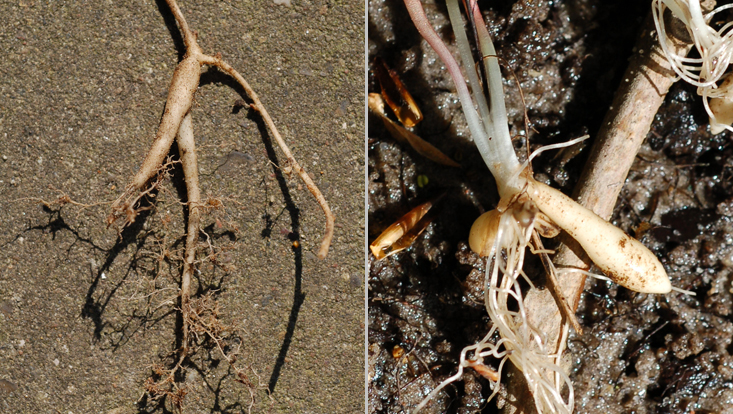
Photo: UHH/Rohwer
Storage roots (Campanula rapunculoides, left) and root tubers (Ficaria verna, right)
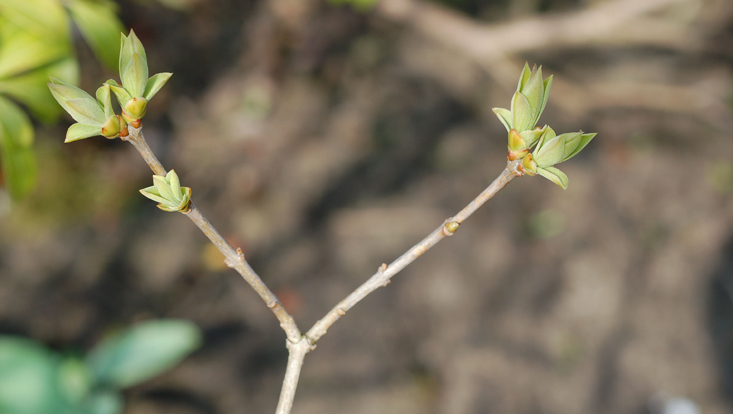
Photo: UHH/Rohwer
Dichasial vegetative branching in (Syringa vulgaris)
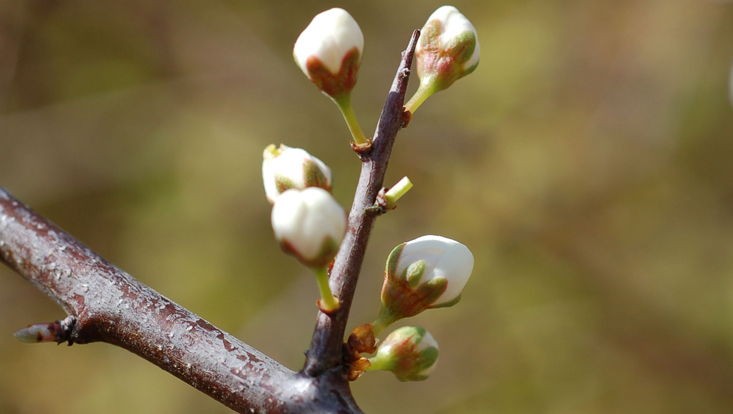
Photo: UHH/Rohwer
Spine (pointed woody brachyblast) of Prunus spinosa bearing flower buds
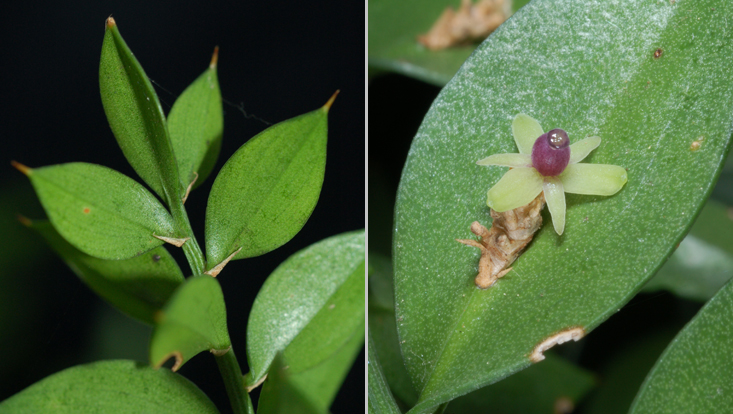
Photo: UHH/Rohwer
Phylloclades (leaf-like stems) of Ruscus aculeatus, in the right photo with a flower
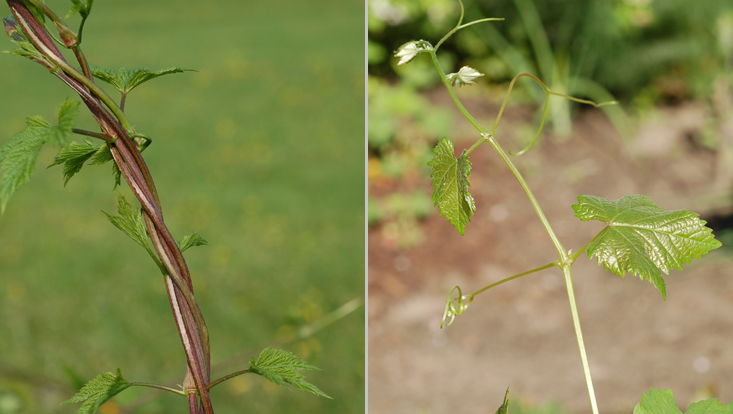
Photo: UHH/Rohwer
Scandent plants: twining in Humulus lupulus (left); by shoot tendrils in Vitis vinifera (right)
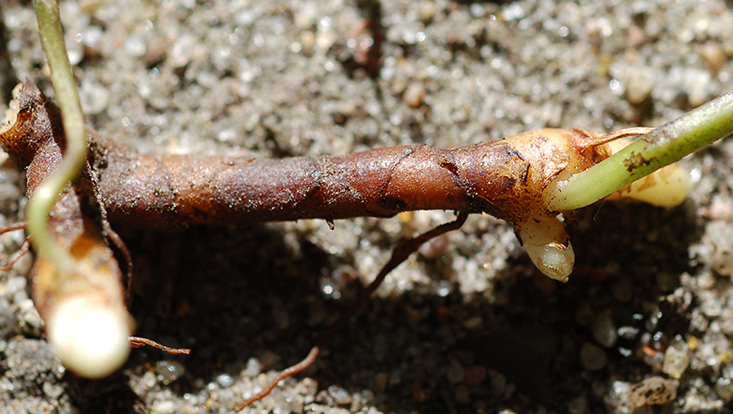
Photo: UHH/Rohwer
Rhizome = a subterranean stem serving as storage organ, in Anemone nemorosa
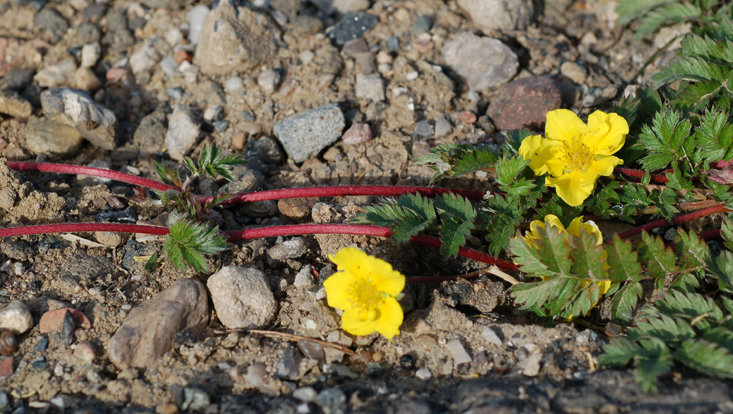
Photo: UHH/Rohwer
Stolons = elongated stems as a means of vegetative reproduction in Potentilla anserina
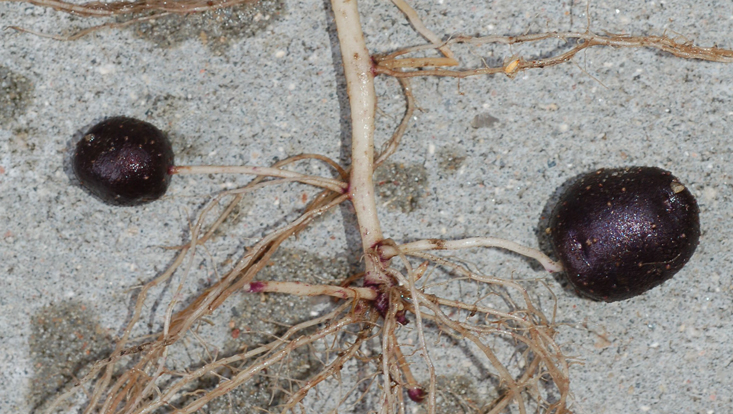
Photo: UHH/Rohwer
Stolons forming tubers in Solanum tuberosum
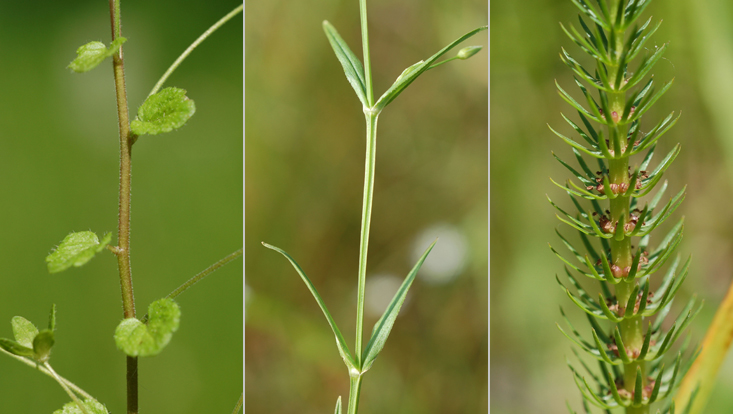
Photo: UHH/Rohwer
The three basic types of leaf arrangement: 1 leaf per node = alternate (Veronica filiformis, left); 2 leaves per node = opposite (Stellaria graminea, center); > 2 leaves per node = verticillate (Hippuris vulgaris, right)
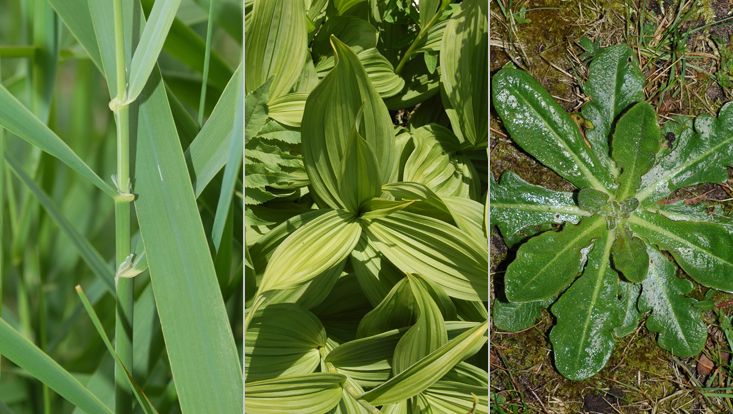
Photo: UHH/Rohwer
Photos of special cases of alternate leaf arrangement: distichous in Phalaris arundinacea (left); tristichous in Ceratrum album (center); spiral (3/8) in Hypochaeris radicata (right)
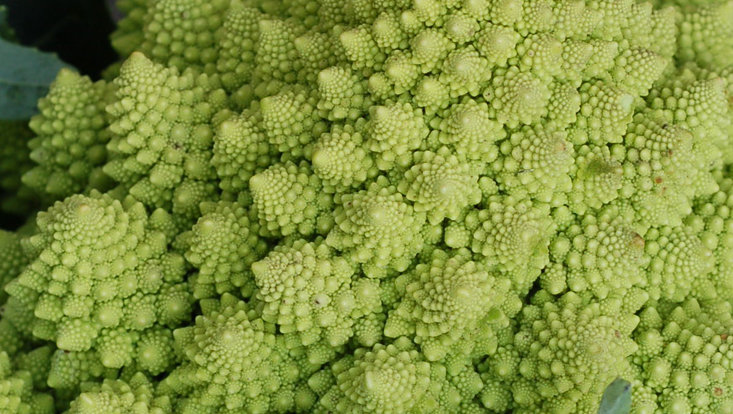
Photo: UHH/Rohwer
Perfect spirals in Romanesco cabbage (Brassica oleracea var. botrytis), organs following each other with the limit divergence angle of ca. 137.5°
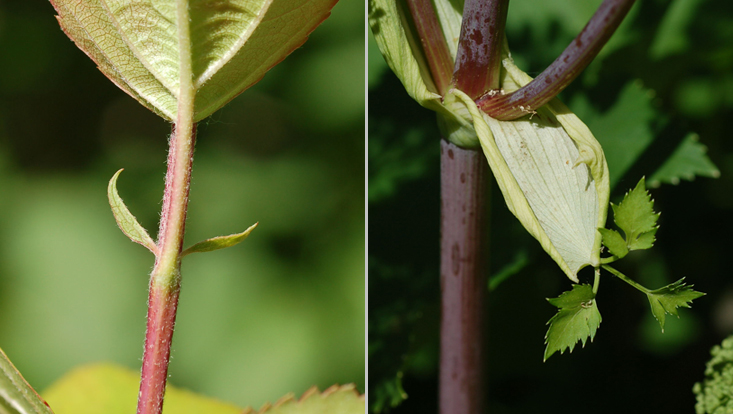
Photo: UHH/Rohwer
Structures of the leaf base: stipules in Malus spec. (left); leaf sheath in Angelica archangelica (right)
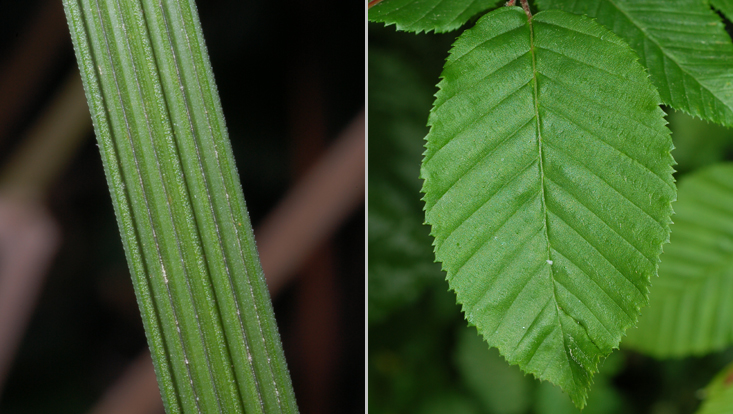
Photo: UHH/Rohwer
Basic types of leaf venation: parallel in Deschampsia caespitosa (left); pinnate in Carpinus betulus (right)
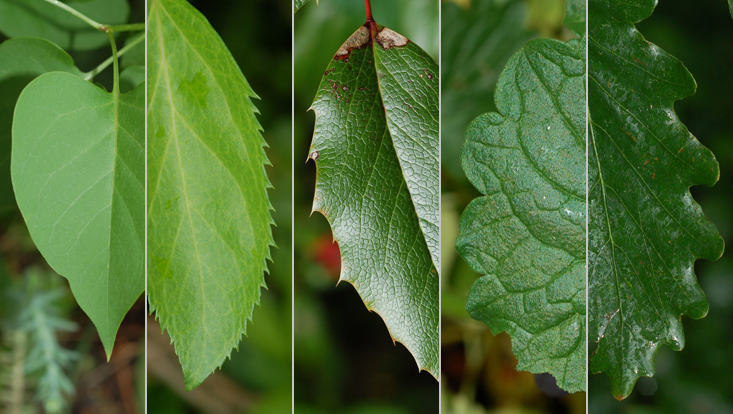
Photo: UHH/Rohwer
Leaf margins, from left to right: entire (Syringa vulgaris); serrate (Forsythia intermedia); aculeate-dentate (Mahonia aquifolium); crenate (Glechoma hederacea); sinuate (Quercus petraea)
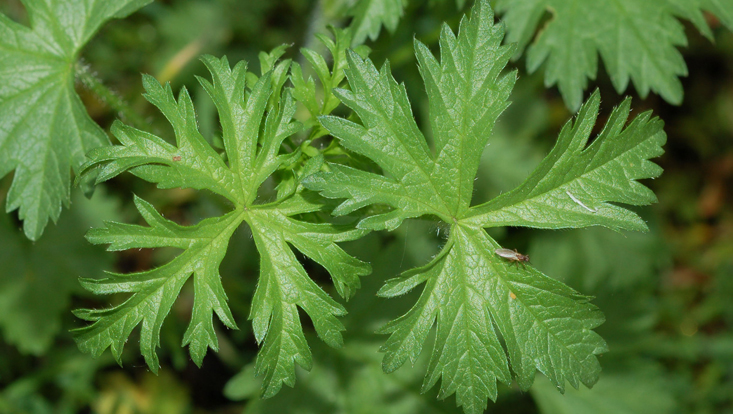
Photo: UHH/Rohwer
Palmately dissected leaves in Malva moschata
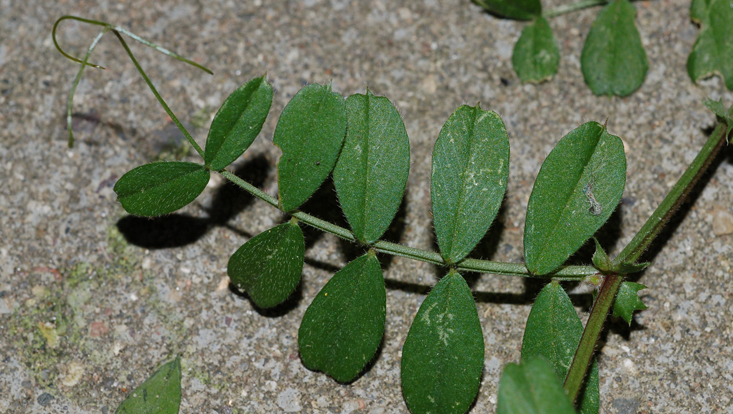
Photo: UHH/Rohwer
Pinnate leaf of a vetch (Vicia spec.), with stipules and tendrils
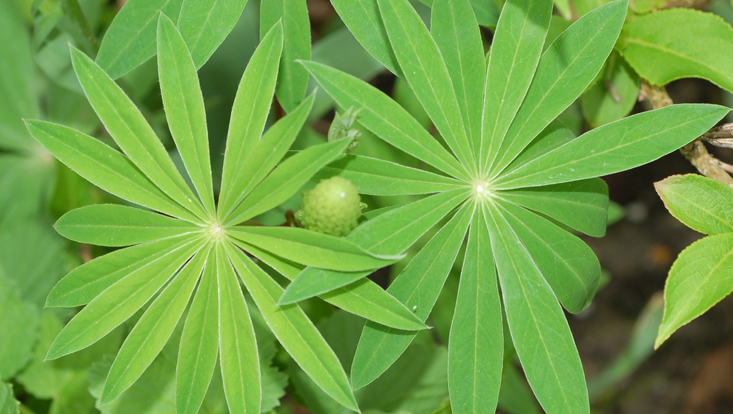
Photo: UHH/Rohwer
Palmately compound leaves of Lupinus polyphyllus

Photo: UHH/Rohwer
Simple racemose inflorescences, from left to right: raceme = axis elongate, flowers pedicellate (Brassica napus); spike = axis elongate, flowers sessile (Orobanche hederae); umbel = axis extremly short, flowers pedicellate (Astrantia major); capitulum = head = axis extremely short, flowers sessile (Scabiosa lucida)
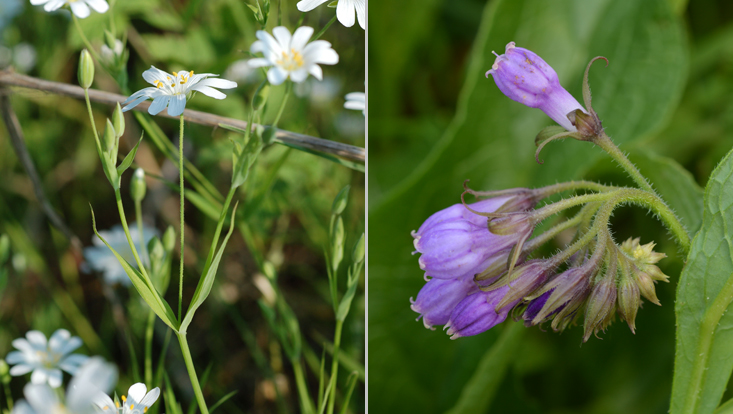
Photo: UHH/Rohwer
Cymose inflorescences: dichasium (Stellaria holostea, left); scorpioid cyme (Symphytum officinale, right)
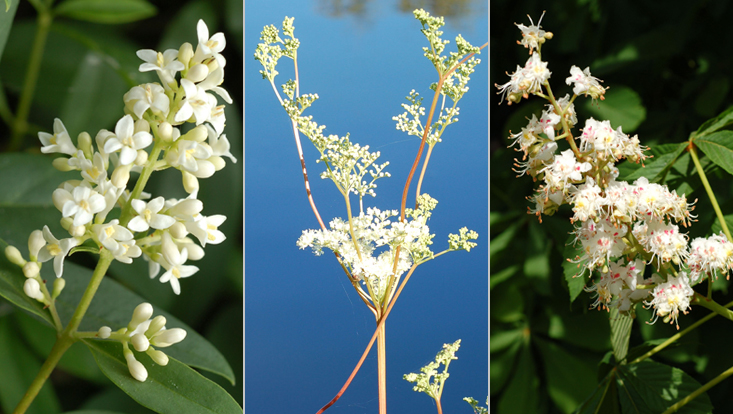
Photo: UHH/Rohwer
Compound inflorescences: panicle (Ligustrum vulgare, left); funnel-shaped corymb (Filipendula ulmaria, center); thyrse (Aesculus hippocastanum, right)
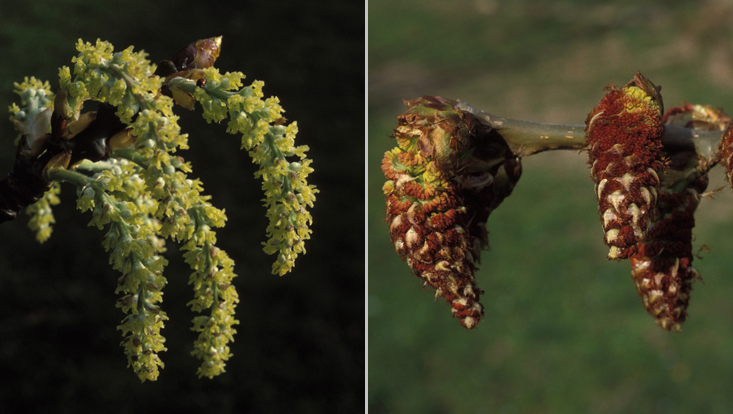
Photo: UHH/Rohwer
Inflorescences (catkins) of poplars (Populus spp.): pistillate (left) and staminate (right)
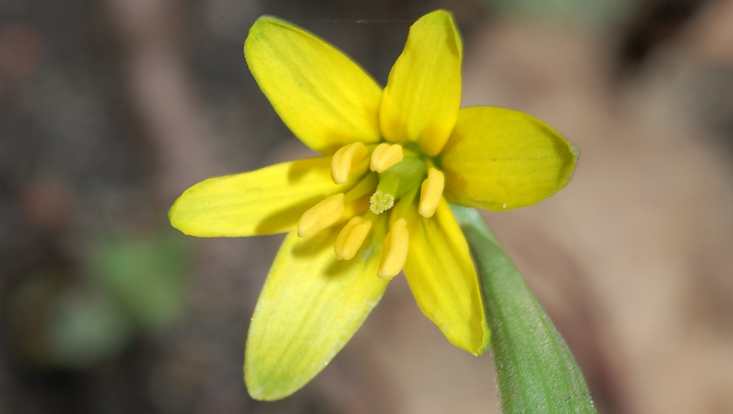
Photo: UHH/Rohwer
Flower of Gagea lutea, with a perigone = perianth parts more or less equal
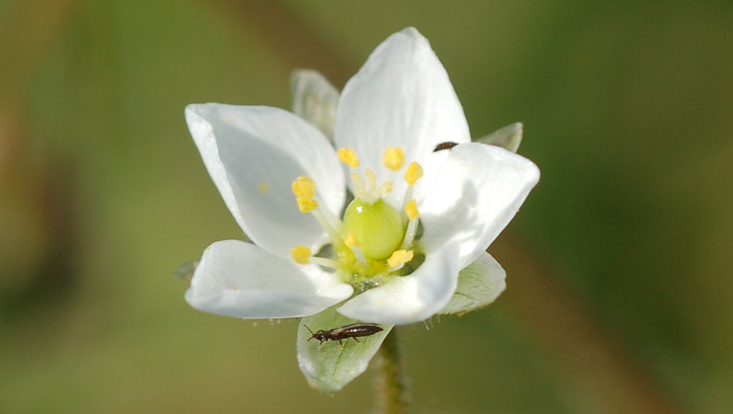
Photo: UHH/Rohwer
Flower of Spergula arvensis, with perianth consisting of calyx and corolla
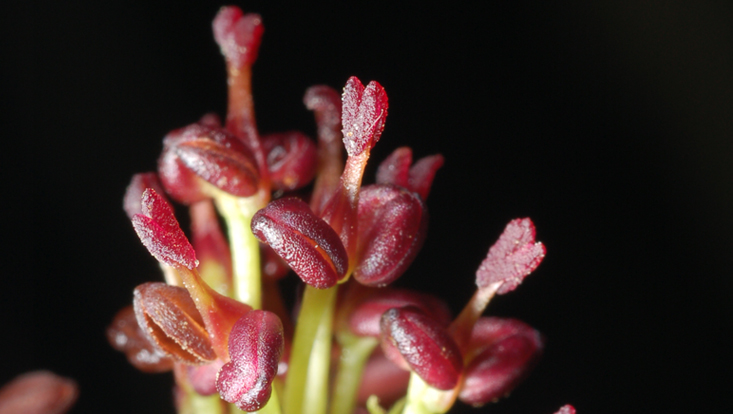
Photo: UHH/Rohwer
Apochlamydeous flowers (= without any perianth) of the common ash (Fraxinus excelsior)
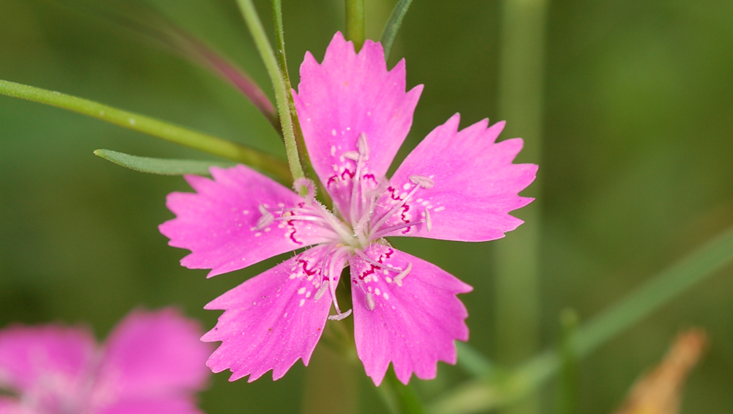
Photo: UHH/Rohwer
Flower of Dianthus deltoides: actinomorphic = with more than 2 planes of symmetry
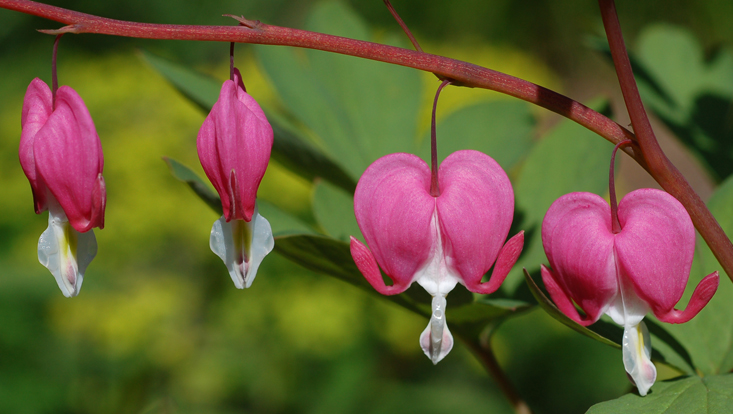
Photo: UHH/Rohwer
Flowers of the bleeding heart (Lamprocapnos spectabilis): disymmetric = with 2 planes of symmetry perpendicular to one another
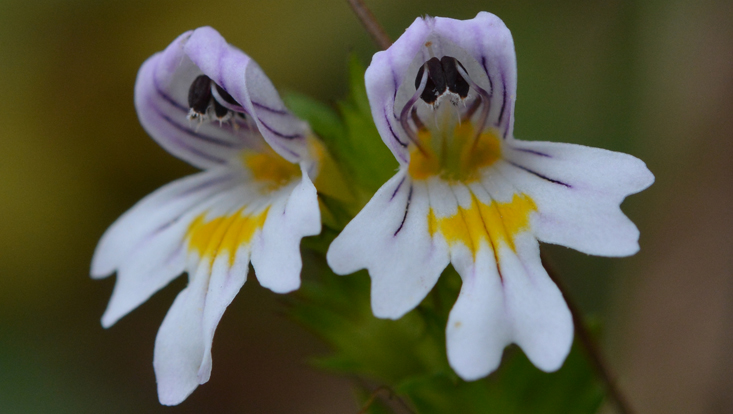
Photo: UHH/Rohwer
Flowers of Euphrasia officinalis: zygomorphic = with a single plane of symmetry
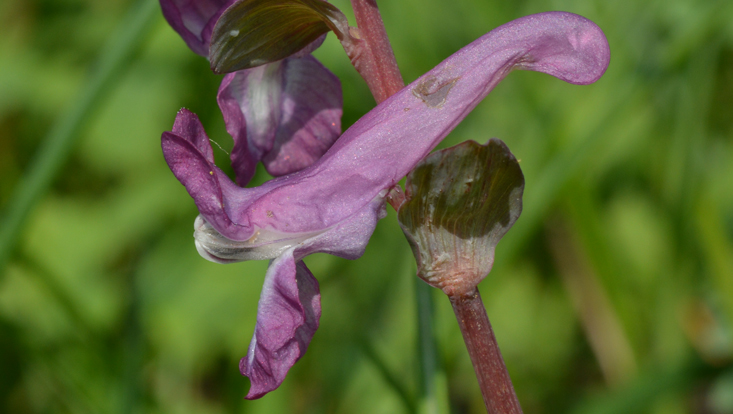
Photo: UHH/Rohwer
Flowers of Corydalis cava, their spur chewed open by bumblebees
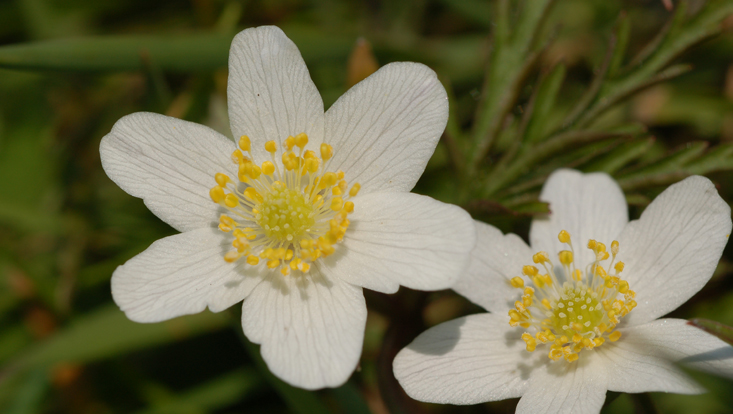
Photo: UHH/Rohwer
Flowers of Anemone nemorosa (Ranunculaceae), with a perigone = perianth parts more or less equal and a polymerous androecium = stamens numerous
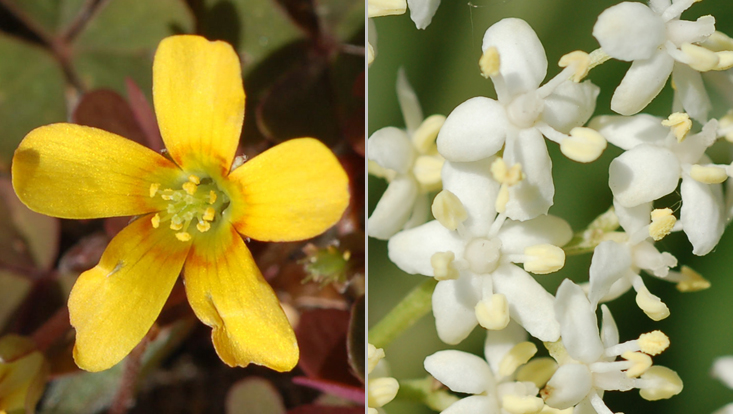
Photo: UHH/Rohwer
Flowers with diplostemonous androeceum = twice as many stamens as petals (Oxalis corniculata, left) and with haplostemonous androeceum = as many stamens as petals (Sambucus nigra, right)
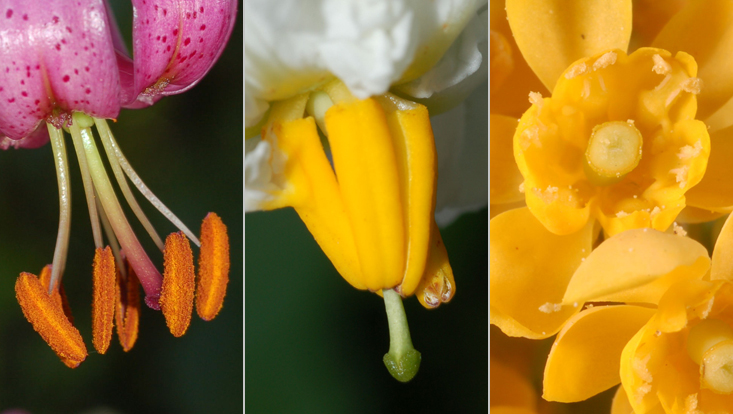
Photo: UHH/Rohwer
Different types of anther dehiscence: longicidal = lengthwise, the most common type (Lilium martagon, left), poricidal = with pores or very short slits (Solanum tuberosum, center), and valvate = with flaps (Mahonia aquifolium, right)
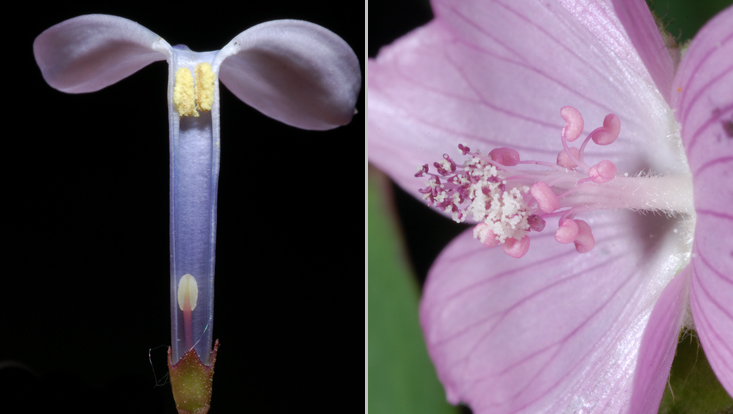
Photo: UHH/Rohwer
Fusion of filaments: with the corolla tube, leading to a joint stamen-corolla tube (Syringa vulgaris, left); with each other, leading to a filament tube separate from the corolla (Malva moschata, right)
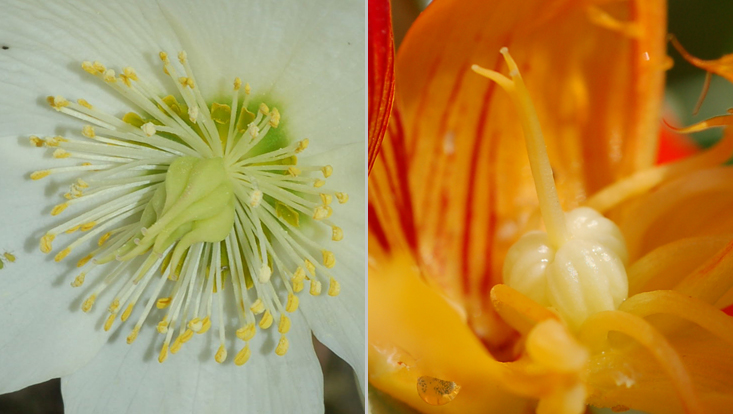
Photo: UHH/Rohwer
Gynoecia: choricarpous = consisting of several free carpels (Helleborus niger, left); coenocarpous = consisting of several (here 3) fused carpels (Tropaeolum majus, right), note single style with 3 stigmatic branches
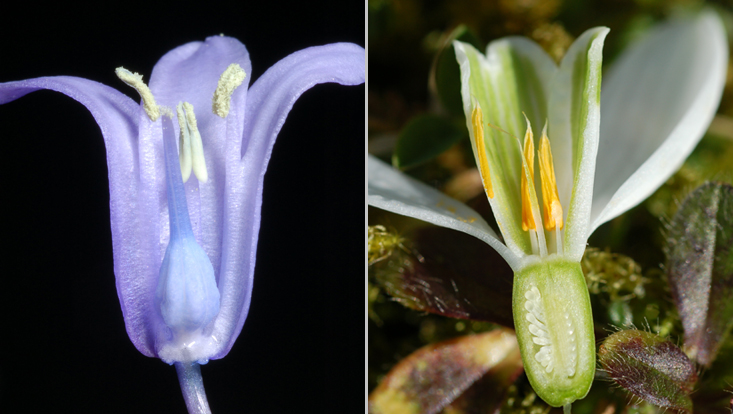
Photo: UHH/Rohwer
Ovary positions: superior = flower hypogynous = all other floral parts inserted below the insertion of the gynoecium (Hyacinthoides non-scripta, left); inferior = flower epigynous = all other flower parts inserted on top of the ovary (Galanthus nivalis, right)
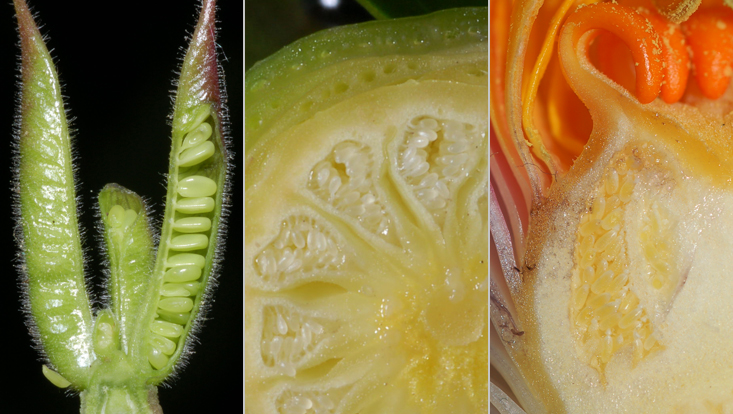
Photo: UHH/Rohwer
Placentation types in choricarpous gynoecia: submarginal = along the ventral suture of the carpel (Aquilegia vulgaris, left) and laminal = scattered on the entire surface (Nymphaea), in cross section (center) and longitudinal section (right)
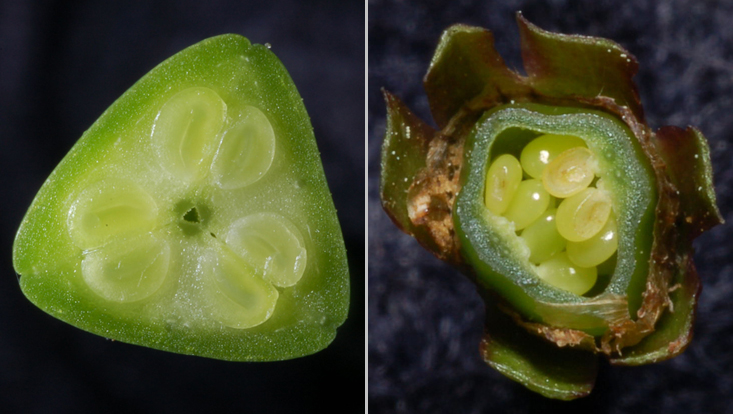
Photo: UHH/Rohwer
Placentation types in coenocarpous gynoecia: axile = in the center of a septate ovary (Tulipa gesneriana, left); parietal = on the ovary wall (Menyanthes trifoliata, right)
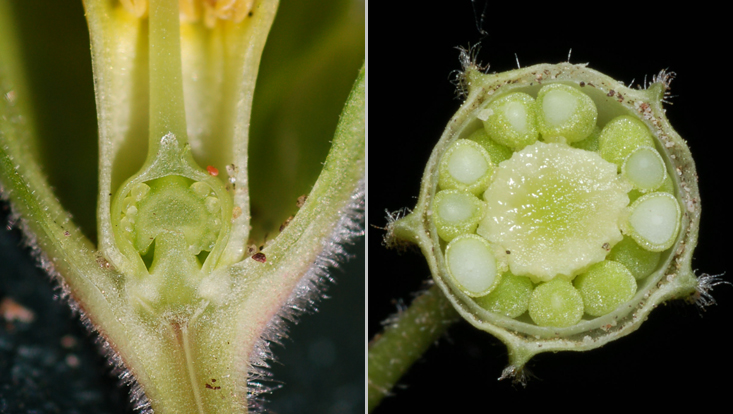
Photo: UHH/Rohwer
Free central placentation in Primula vulgaris: longitudinal section of flower (left); cross section of young fruit (right)
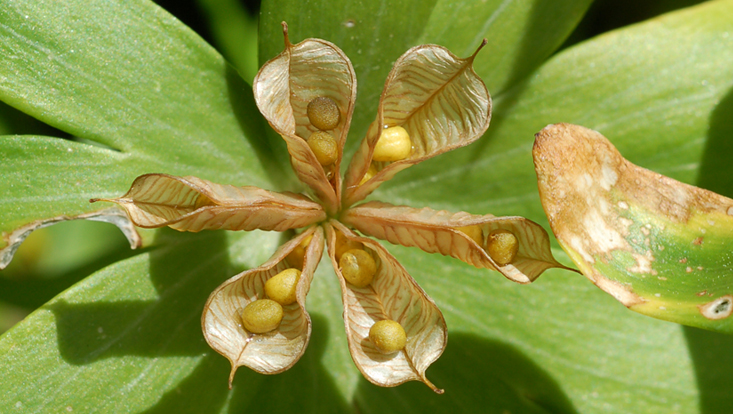
Photo: UHH/Rohwer
Open follicles in Eranthis hyemalis
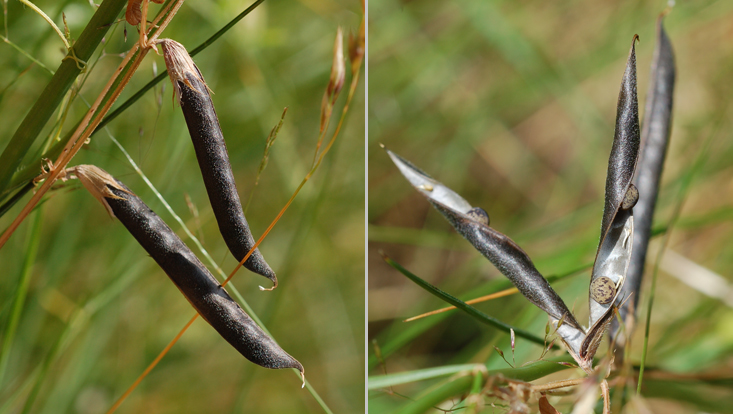
Photo: UHH/Rohwer
Legumes of Vicia sativa: mature but still closed (left); dehisced (right)
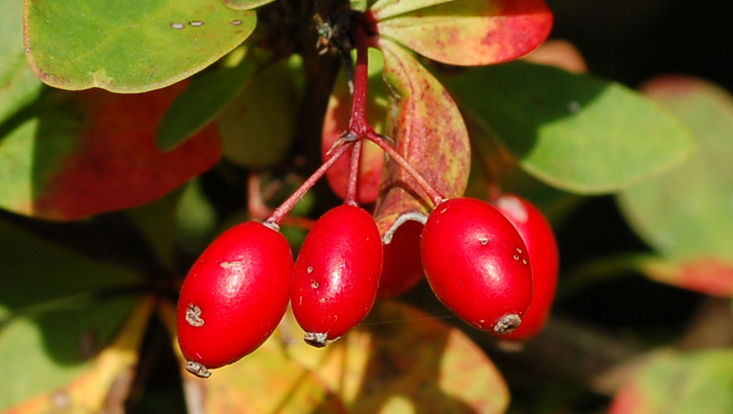
Photo: UHH/Rohwer
Monocarpellate berries in Berberis thunbergii
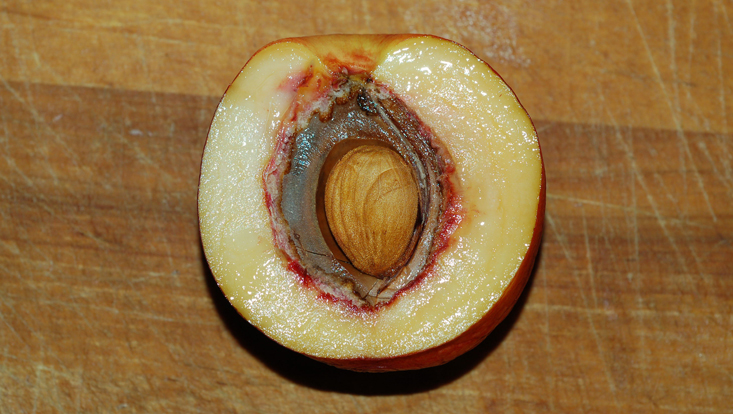
Photo: UHH/Rohwer
Peach (Prunus persica), longitudinal section
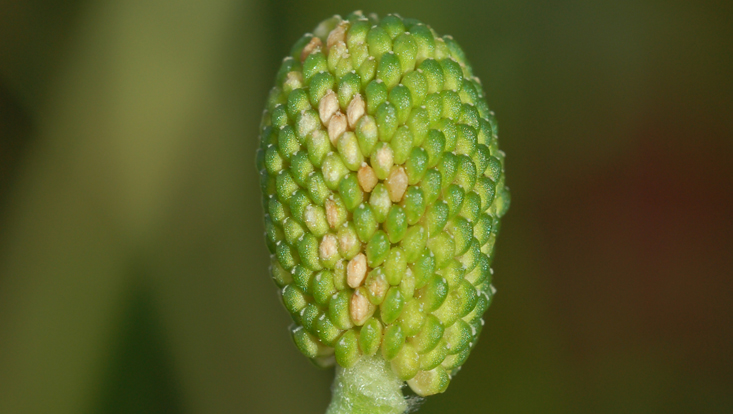
Photo: UHH/Rohwer
Nutlets in Ranunculus sceleratus
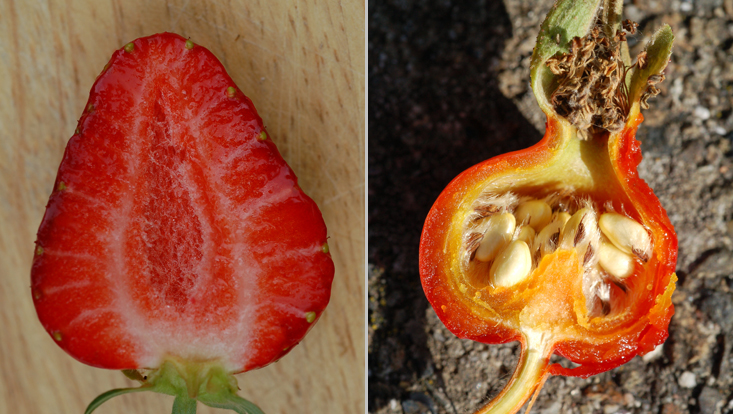
Photo: UHH/Rohwer
Fleshy fruits with nutlets: strawberry (Fragaria x ananassa, left), with a buldging receptacle as the fleshy part; hip of Japanese rose (Rosa rugosa, right), with hypanthium as the fleshy part
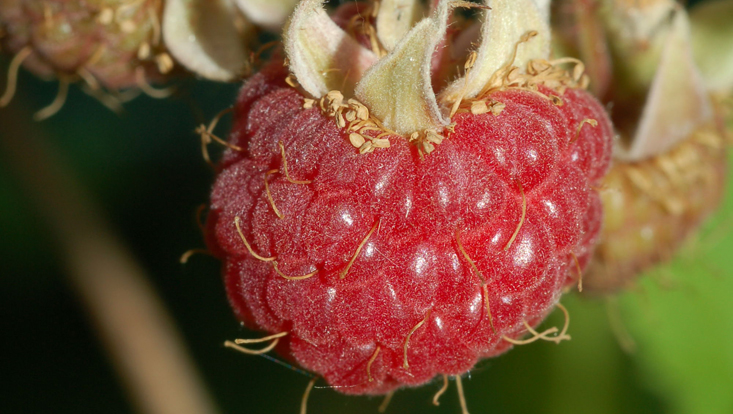
Photo: UHH/Rohwer
Fruit consisting of drupelets in raspberry (Rubus idaeus); sepals, stamens and styles still preserved
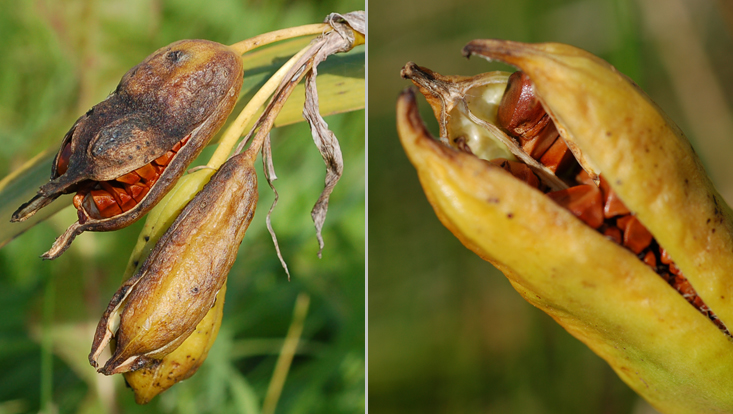
Photo: UHH/Rohwer
Fruits (loculicidal capsules) of Iris pseudacorus
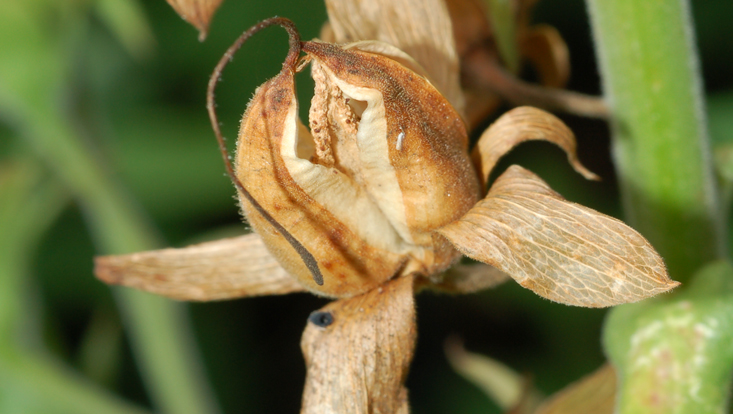
Photo: UHH/Rohwer
Septicidal capsule = opening in the plane of the septa in Digitalis purpurea
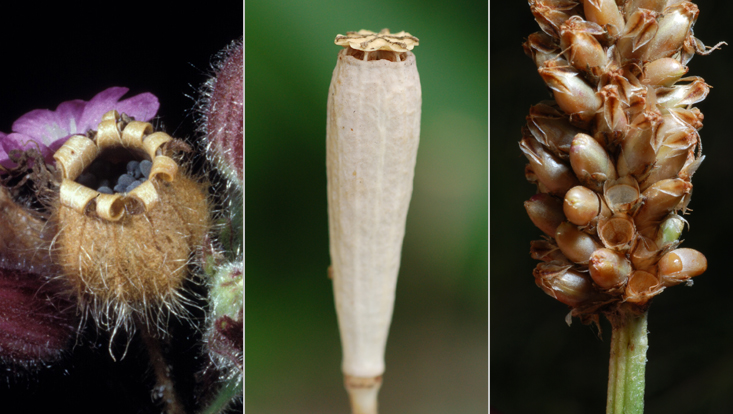
Photo: UHH/Rohwer
Capsules with special types of dehiscence: valvate by teeth in Silene dioica (left); poricidal = by pores in Papaver dubium (center); operculate = with a lid in Plantago lanceolata (right)
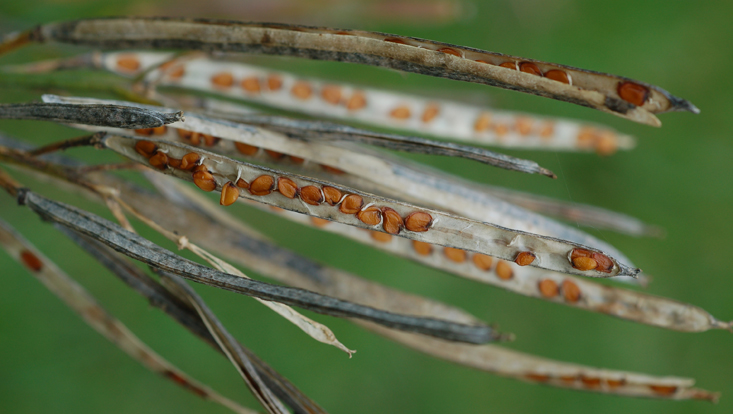
Photo: UHH/Rohwer
Fruits (siliques) of Erysimum cheiri

Photo: UHH/Rohwer
Longitudinal section of a tomato (Lycopersicon esculentum), a berry with fleshy pericarp and sarcotestal seeds
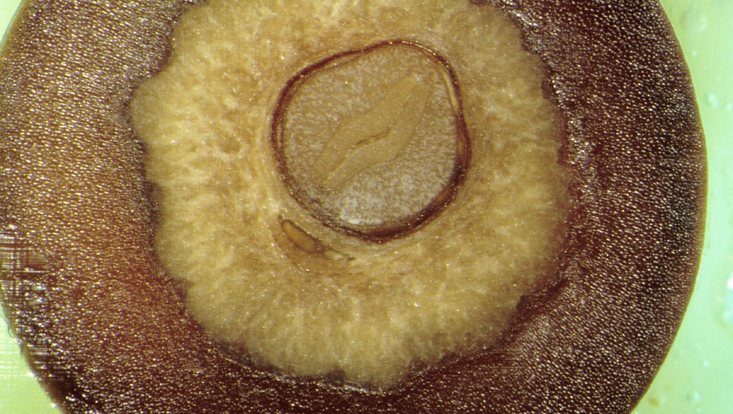
Photo: UHH/Rohwer
Cross section of an olive (Olea europaea), a bicarpellate drupe; testa, endosperm and embryo visible in the only developed seed, septum and an aborted ovule in the second locule visible; embedded in methacrylate resin
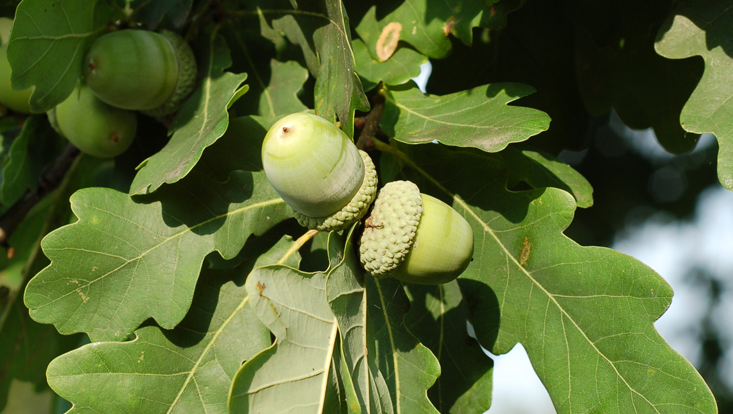
Photo: UHH/Rohwer
Immature fruits (acorns) of the common oak (Quercus robur); nuts in a cupule
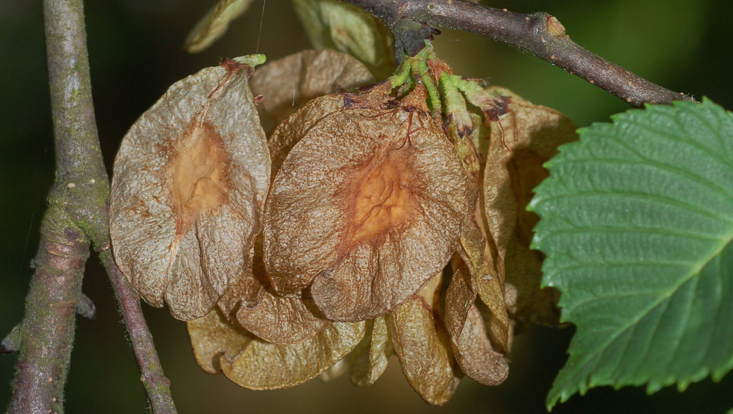
Photo: UHH/Rohwer
Fruits (samaras) of Ulmus glabra
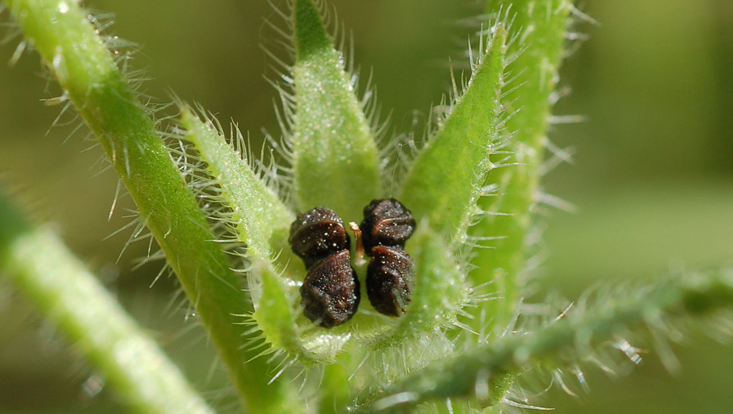
Photo: UHH/Rohwer
Fruit (schizocarp) of Anchusa arvensis
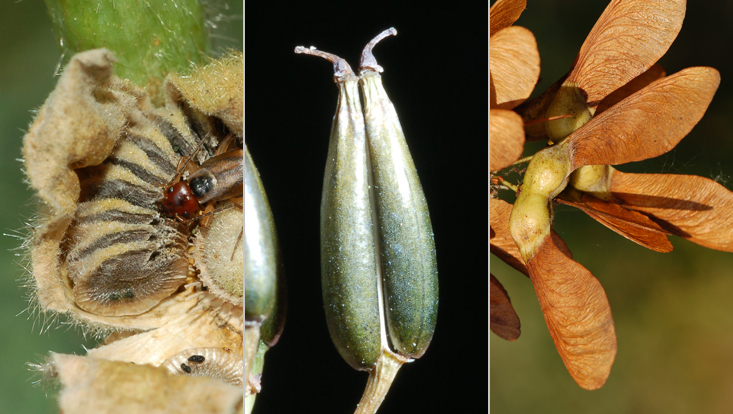
Photo: UHH/Rohwer
Schizocarps: Alcea rosea (left); Anthriscus sylvestris (center); Acer pseudoplatanus (right)
61-705 Determination of Vascular Plants (practical course)
Jens G. Rohwer, Stefan Rust
The ability to determine native vascular plants is important in many fields, such as ecology, conservation, consulting and landscape planning. Here we show how that works, and the students have the opportunity to practice and to improve their skills. The necessary terminology is presented in the lecture "Morphology and Systematics of Native Vascular Plants".
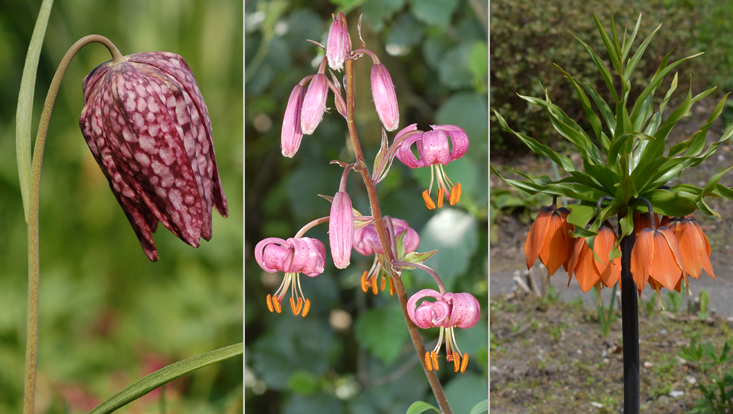
Photo: UHH/Rohwer
Inflorescences of Liliaceae: solitary flower in Fritillaria meleagris (left), raceme in Lilium martagon (center), pseudo-umbel in Fritillaria imperialis (right)
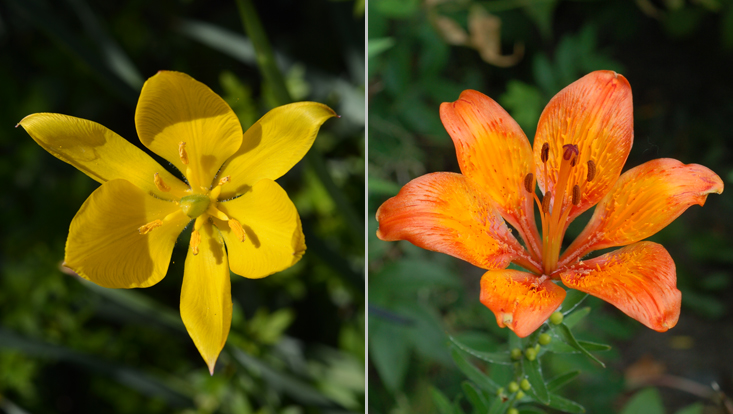
Photo: UHH/Rohwer
Flowers of Liliaceae: Tulipa sylvestris (left) and Lilium bulbiferum (right), showing the typical construction of the family: actinomorphic, with 3+3 (sub)equal tepals, 3+3 stamens and a superior ovary consisting of three fused carpels
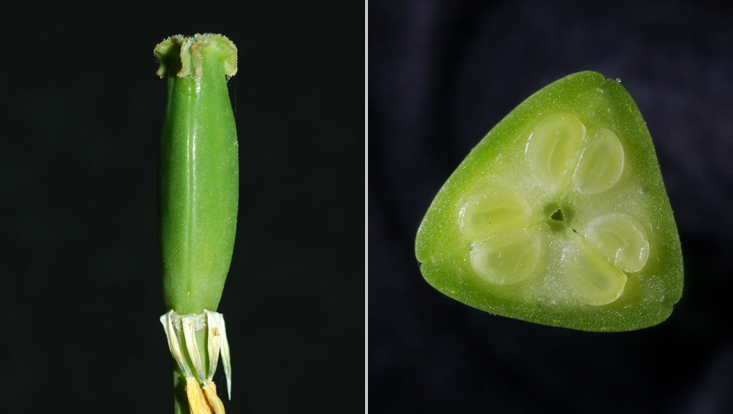
Photo: UHH/Rohwer
Ovary of Tulipa gesneriana: lateral view (left); cross section (right)
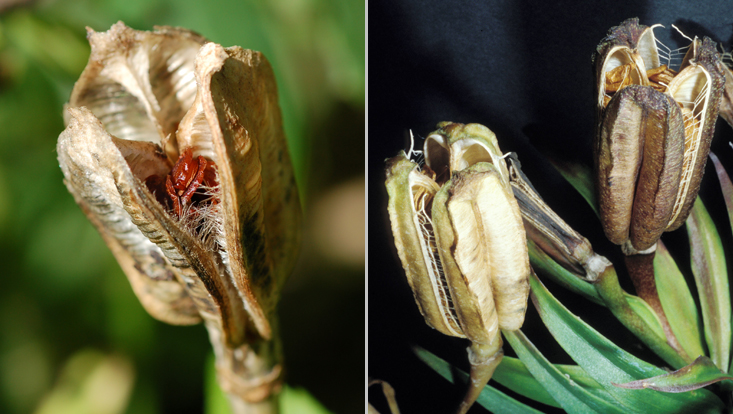
Photo: UHH/Rohwer
Fruits (loculicidal capsules) of Liliaceae: Tulipa gesneriana (left), Lilium regale (right)
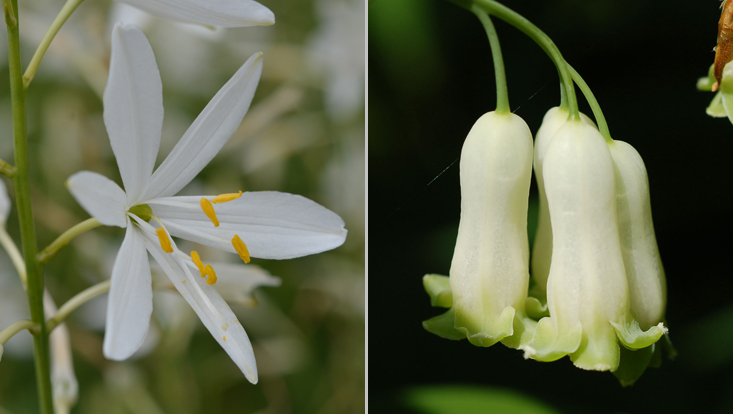
Photo: UHH/Rohwer
Flowers of Asparagaceae: Anthericum liliago (left), with free tepals; Polygonatum multiflorum (right), with fused tepals
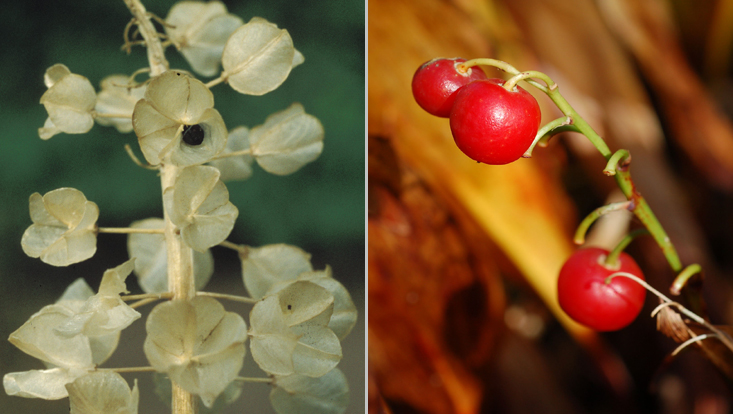
Photo: UHH/Rohwer
Asparagaceae fruits: loculicidal capsules in Muscari botryoides (left), berries in Convallaria majalis (right)
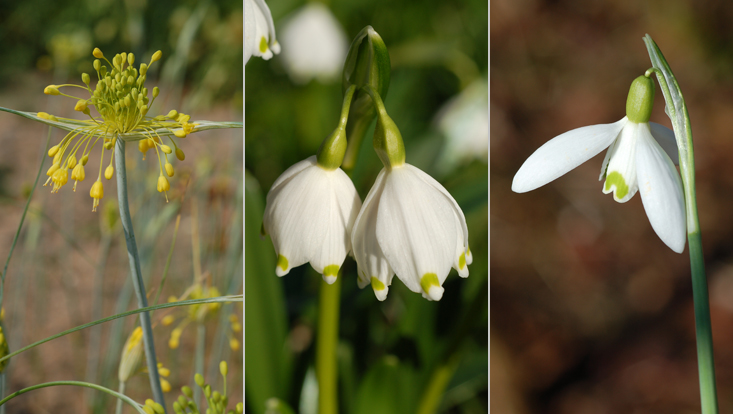
Photo: UHH/Rohwer
Inflorescences in Amaryllidaceae: many-flowered (pseudo-)umbel in Allium flavum (left); two-flowered umbel in Leucojum vernum (center); single flower in Galanthus nivalis (right)
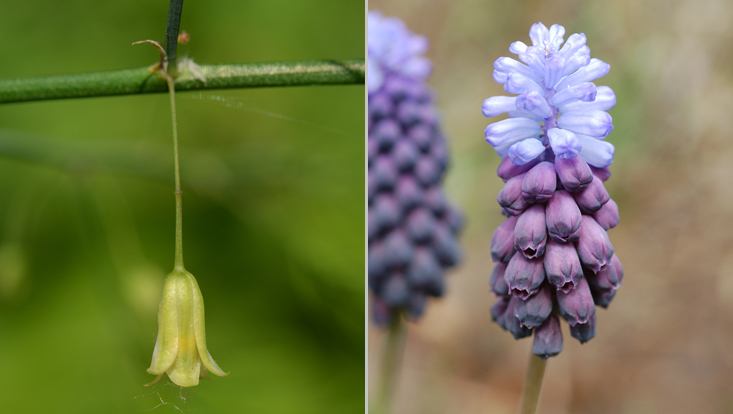
Photo: UHH/Rohwer
Inflorescences in Asparagaceae: solitary flower in Asparagus officinalis (left); raceme in Muscari latifolium (right)
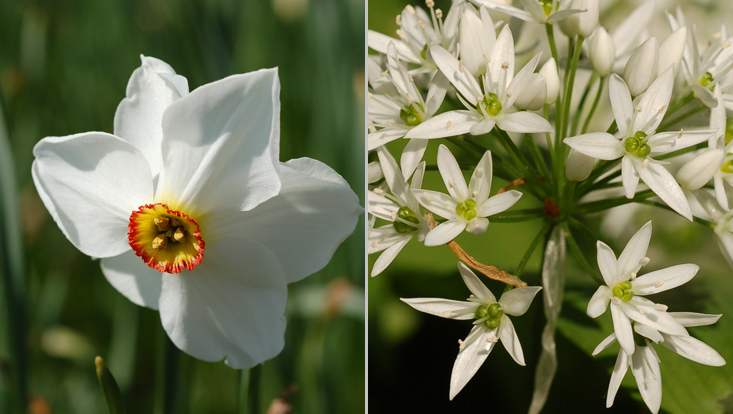
Photo: UHH/Rohwer
Amaryllidaceae flowers: Narcissus poeticus (left), with a paracorolla; Allium ursinum (right), an exception within the family because of its superior ovary
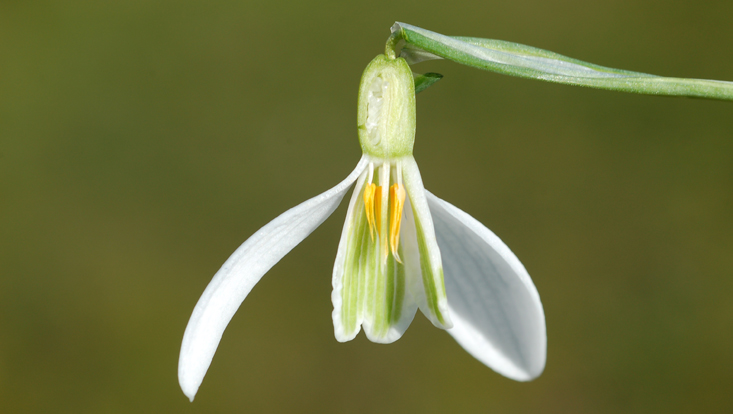
Photo: UHH/Rohwer
Flower of Galanthus nivalis (Amaryllidaceae), longitudinal section, showing inferior ovary
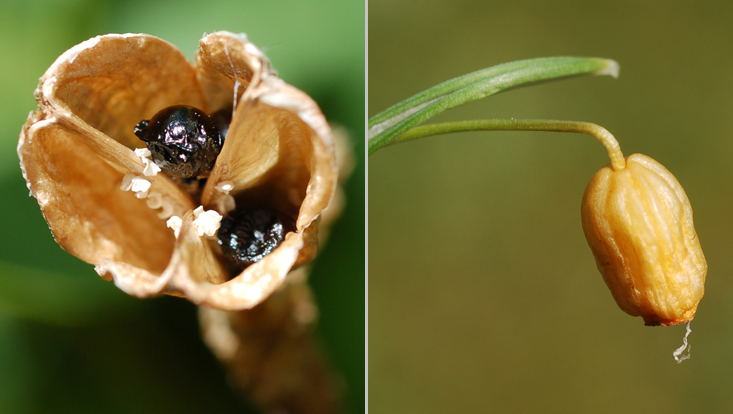
Photo: UHH/Rohwer
Amaryllidaceae fruits: Narcissus pseudonarcissus (left), a loculicidal capsule; Galanthus nivalis (right), a transitional form between capsule and berry
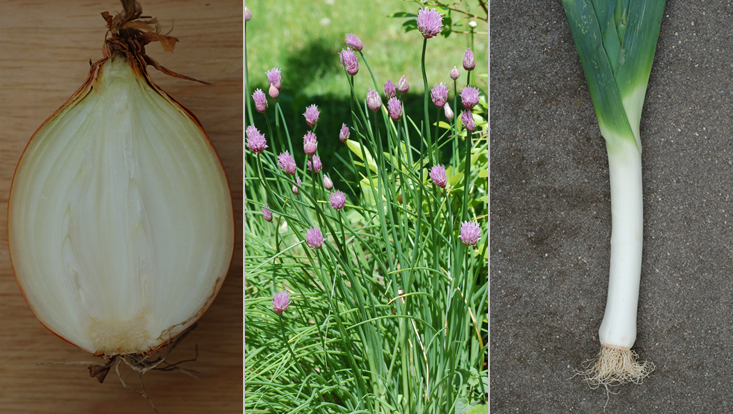
Photo: UHH/Rohwer
Crops plants in Amaryllidaceae: Onion (Allium cepa, left), longitudinal section of the bulb; Chives (Allium schoenoprasum, center), flowering plant; Leek (Allium porrum, right)
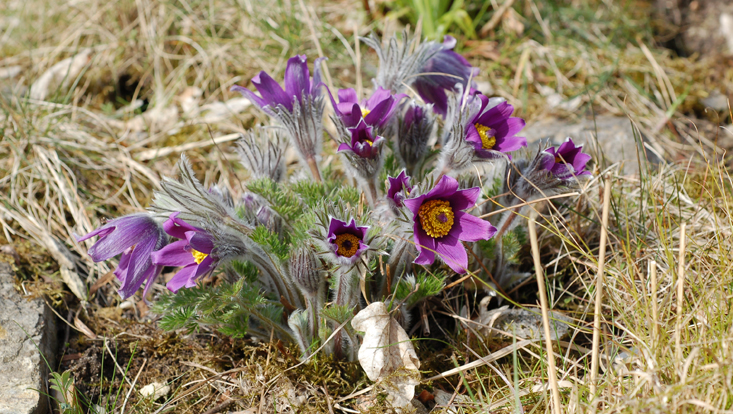
Photo: UHH/Rohwer
Pulsatilla vulgaris (Ranunculaceae)
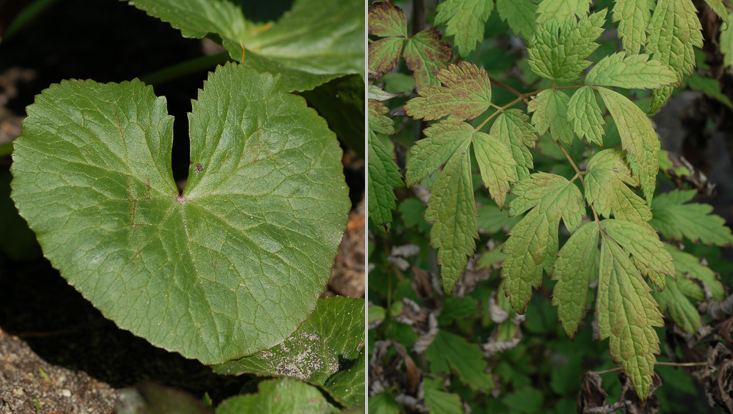
Photo: UHH/Rohwer
Leaves of Ranunculaceae: undivided in Caltha palustris (left); bipinnate in Actaea racemosa (right)
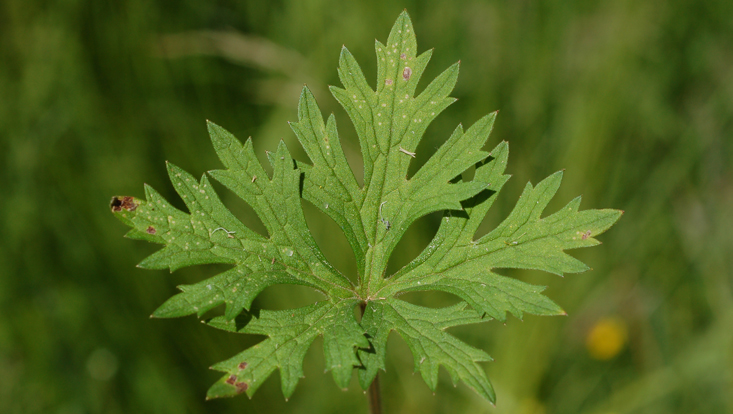
Photo: UHH/Rohwer
Deeply palmately dissected leaf of Ranunculus acris (Ranunculaceae)
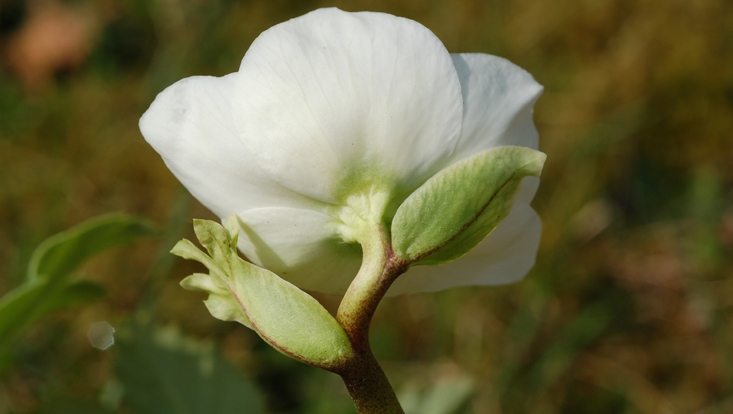
Photo: UHH/Rohwer
Flower of Helleborus niger (Ranunculaceae), seen from back side, with simple perianth and bracts below the flower
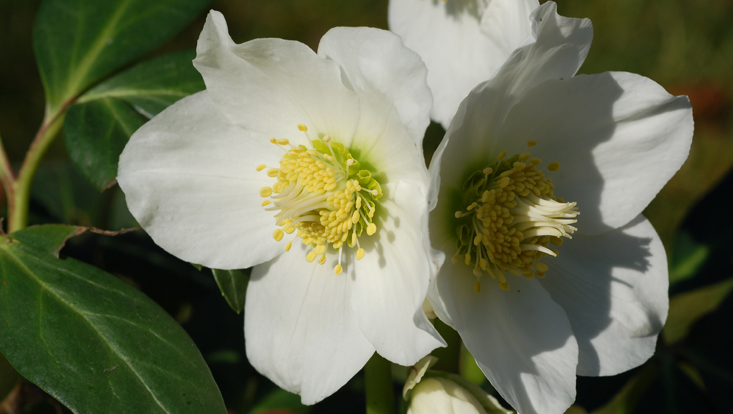
Photo: UHH/Rohwer
Flowers of Helleborus niger (Ranunculaceae), with nectar leaves between perianth and androecium
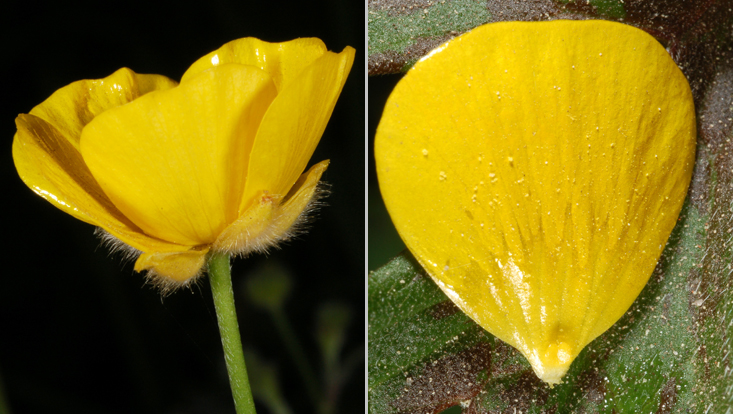
Photo: UHH/Rohwer
Petals derived from nectar leaves in Ranunculus acris (Ranunculaceae): entire flower, lateral view (left); single petal = nectar leaf (right), note nectar gland at the base
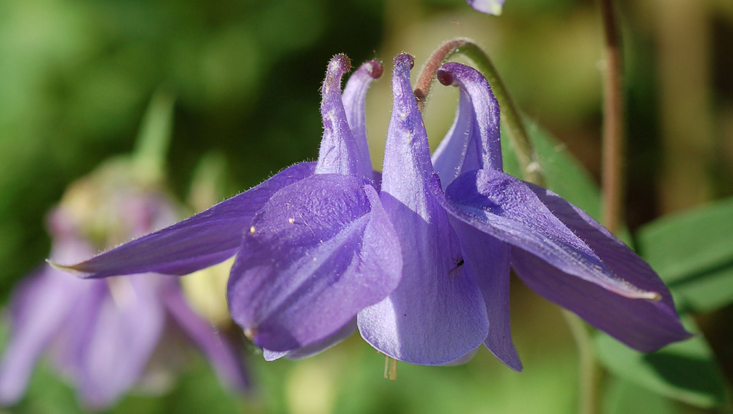
Photo: UHH/Rohwer
Flower of Aquilegia vulgaris (Ranunculaceae), with five spurred nectar leaves
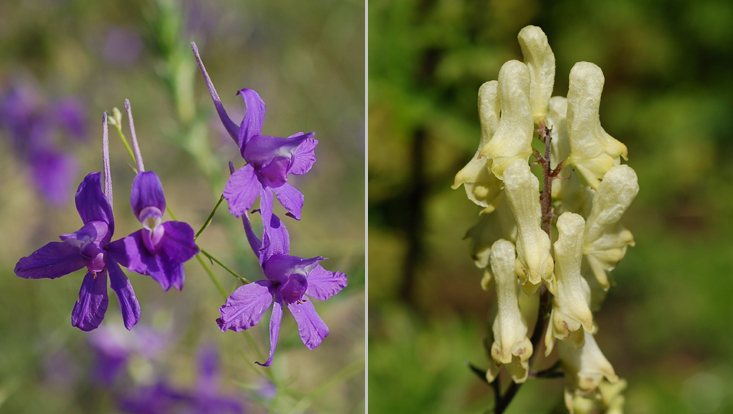
Photo: UHH/Rohwer
Zygomorphic flowers in Ranunculaceae: spurred in Consolida regalis (left); helmet-shaped in Aconitum lycoctonum (right)
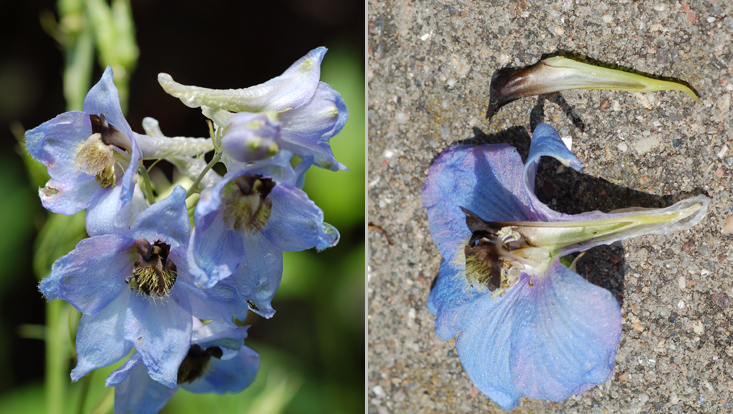
Photo: UHH/Rohwer
Flowers of a garden form of Delphinium elatum (Ranunculaceae): tip of a partial inflorescence (left); longitudinal section of a flower (right), with a nectar leaves reaching deeply into the spur, one of them removed and placed above the flower
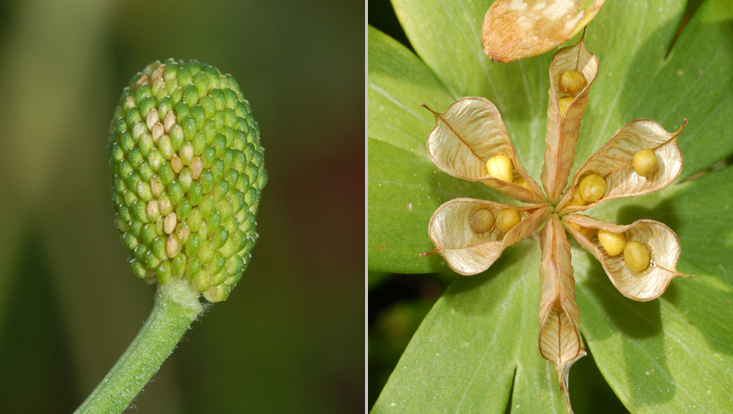
Photo: UHH/Rohwer
The most common fruit types in Ranunculaceae: nutlets in Ranunculus sceleratus (left); follicles in Eranthis hyemalis (right)
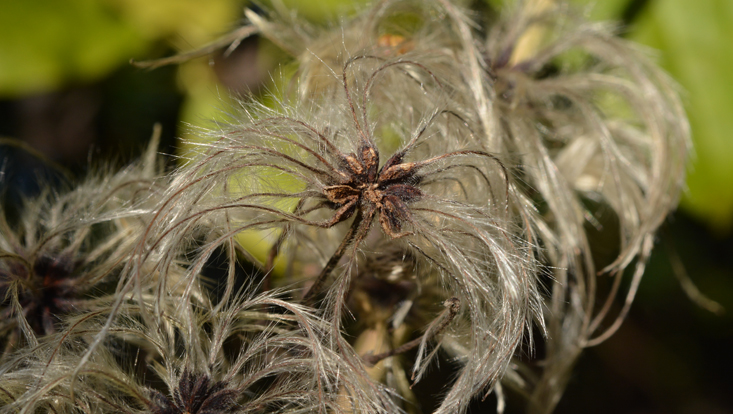
Photo: UHH/Rohwer
Fruit of Clematis vitalba (Ranunculaceae): nutlets with densely pubescent styles
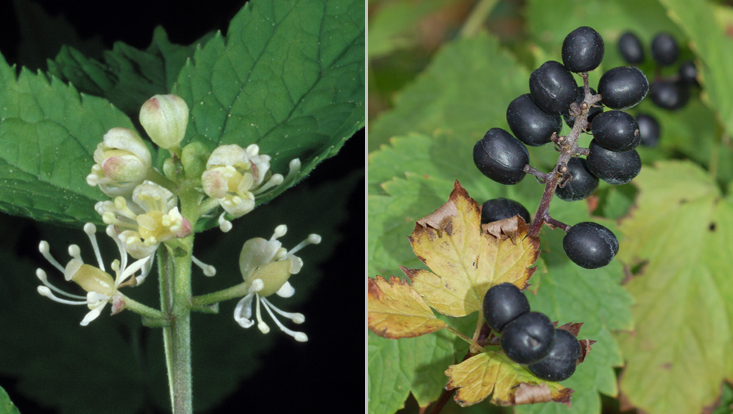
Photo: UHH/Rohwer
Actaea spicata, with its solitary carpel and berries an exception among the Ranunculaceae: flowers (left) and fruits (right)
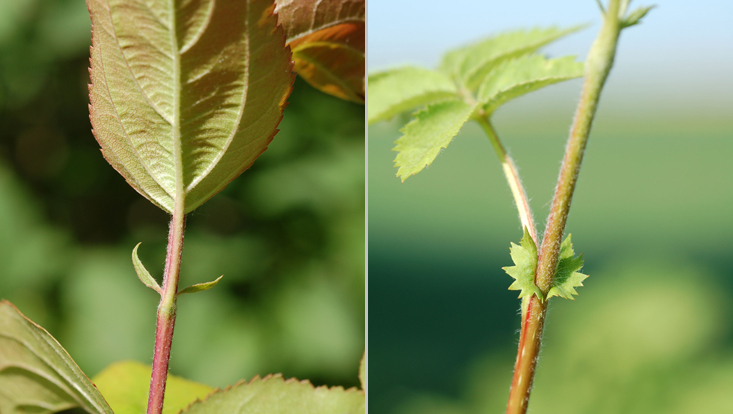
Photo: UHH/Rohwer
Leaf bases of Rosaceae, with stipules: Malus spec. (left); Sorbus aucuparia (right)
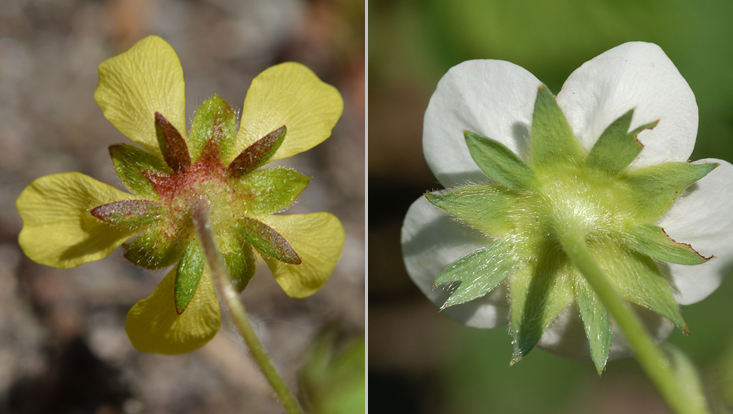
Photo: UHH/Rohwer
Rosaceae flowers with epicalyx, seen from back side: Potentilla neumanniana (left), Fragaria ananassa (right)
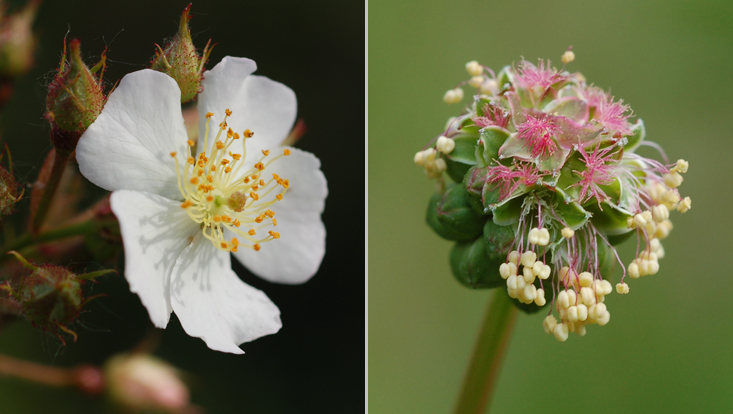
Photo: UHH/Rohwer
Rosaceae flowers: Rosa multiflora (left), with the typical flower construction; Sanguisorba minor (right), with unisexual flowers arranged in a head
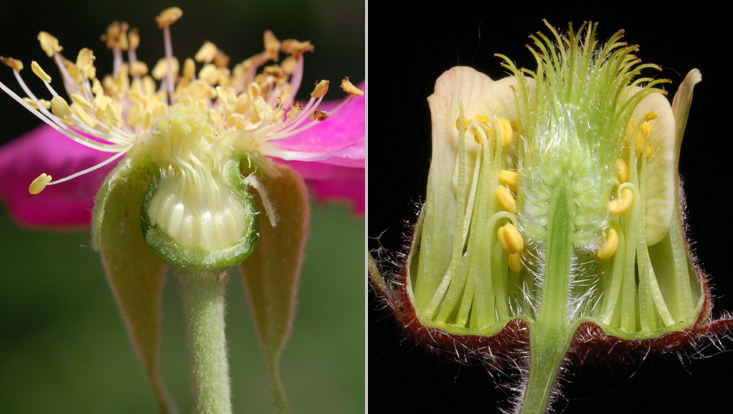
Photo: UHH/Rohwer
Longitudinal sections of Rosaceae flowers: Rosa rugosa (left), carpels enclosed in hypanthium; Geum rivale (right), carpels raised on a gynophore
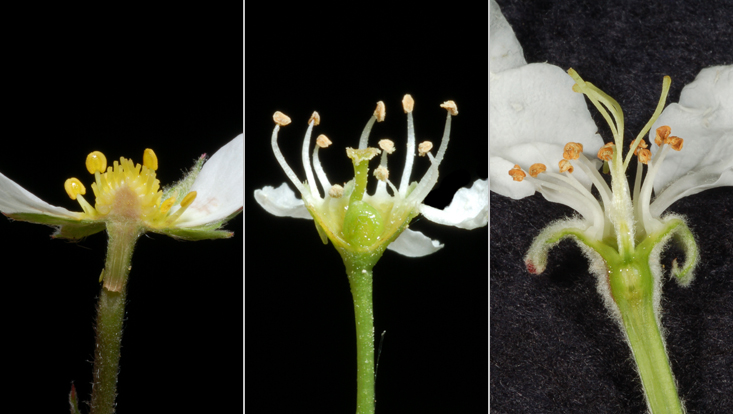
Photo: UHH/Rohwer
Photos of the gynoecium position in Rosaceae: superior = flower hypogynous in Fragaria moschata (left); in hypanthium = flower perigynous in Prunus serotina (center); inferior = flower epigynous in Malus domestica (right)
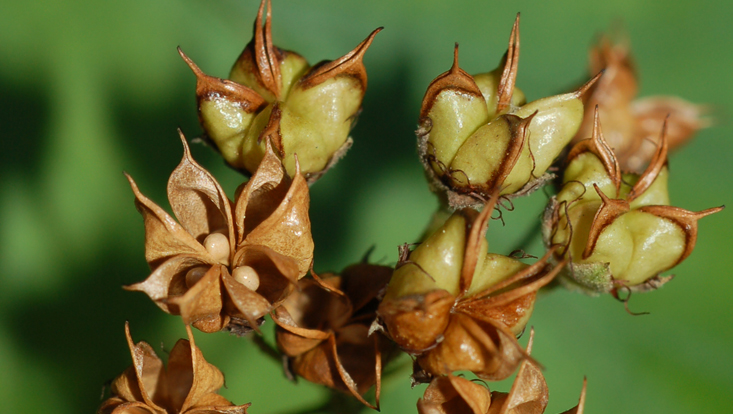
Photo: UHH/Rohwer
Follicles of Physocarpus opulifolius (Rosaceae)
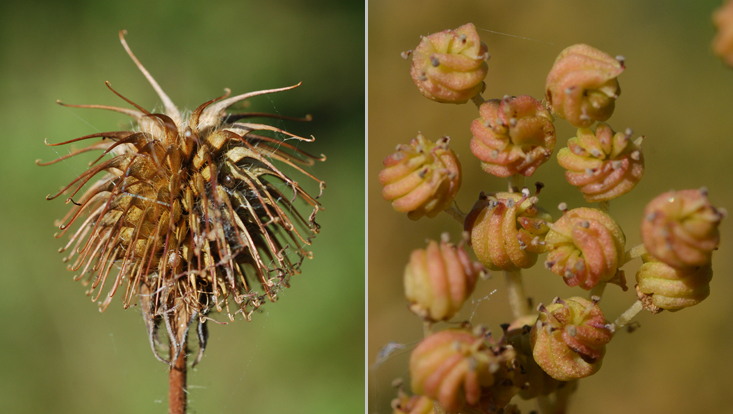
Photo: UHH/Rohwer
Photos of special nutlets in Rosaceae: Geum urbanum (left), with styles acting as barbs; Filipendula ulmaria (right), with twisted nutlets
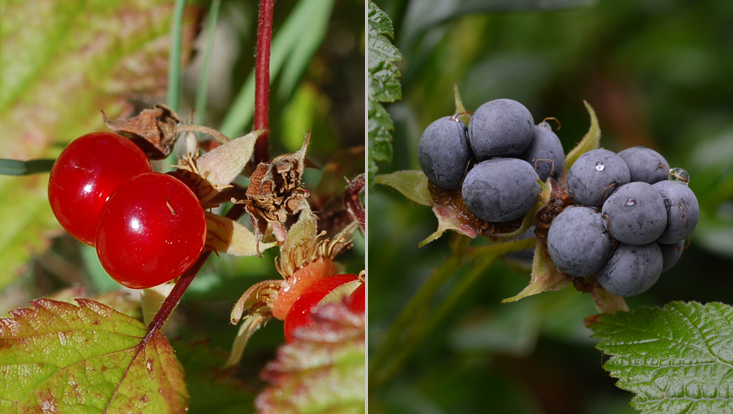
Photo: UHH/Rohwer
Fruits consisting of druplets in Rosaceae: Rubus saxatilis (left); R. caesius (right)

Photo: UHH/Rohwer
Rosaceae, fleshy fruits with nutlets: strawberry (Fragaria x ananassa, left), with enlarged fleshy receptacle; hip of Japanese Rose (Rosa rugosa, right), hypanthium fleshy
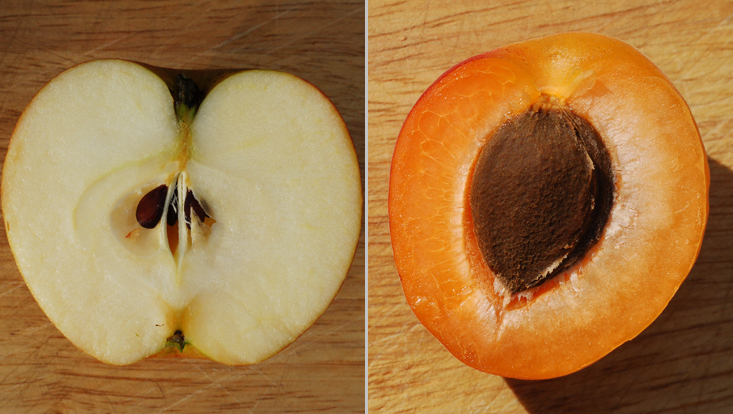
Photo: UHH/Rohwer
Longitudinal sections of fleshy fruits of Rosaceae: Apple (Malus domestica, left), an inferior berry; Apricot (Prunus armeniaca, right), a drupe
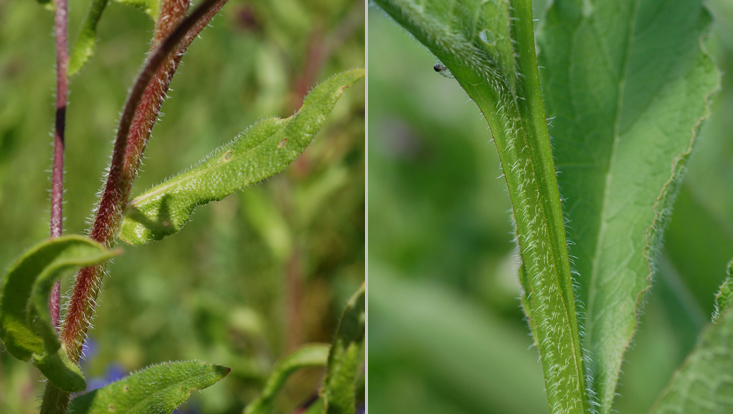
Photo: UHH/Rohwer
Species showing the typical rough indument of Boraginaceae: Achusa azurea (left); Symphytum officinale (right)
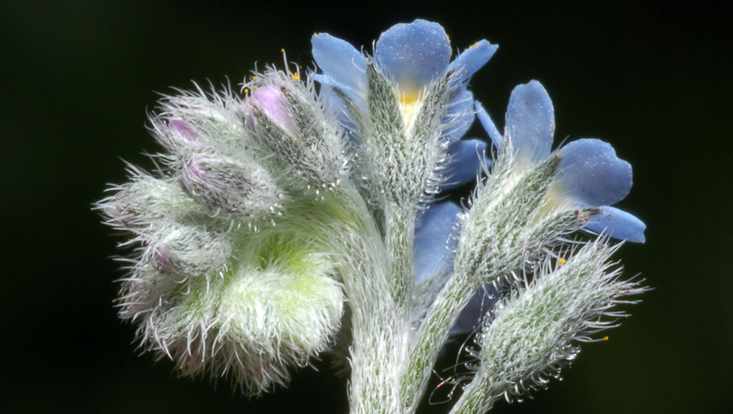
Photo: UHH/Rohwer
Tip of the scorpioid cyme of Myosotis arvensis (Boraginaceae)
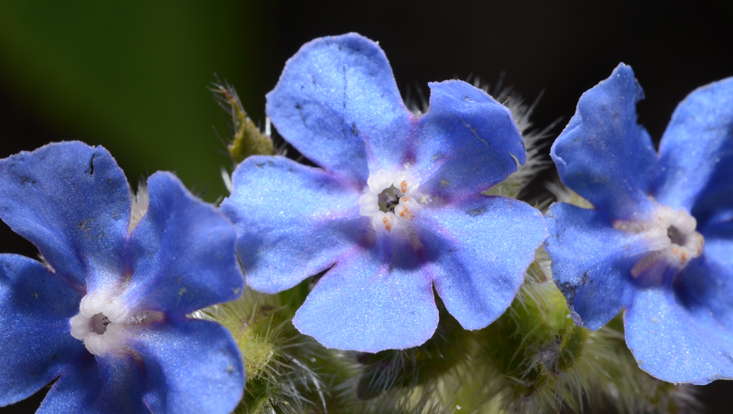
Photo: UHH/Rohwer
Flowers of Pentaglottis sempervirens (Boraginaceae), with protruding faucal scales
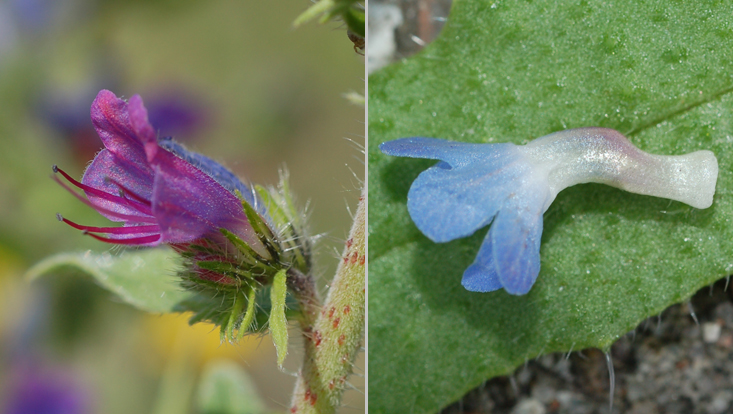
Photo: UHH/Rohwer
Zygomorphic flowers, a rare character in Boraginaceae: Echium vulgare (left), Anchusa arvensis (right)
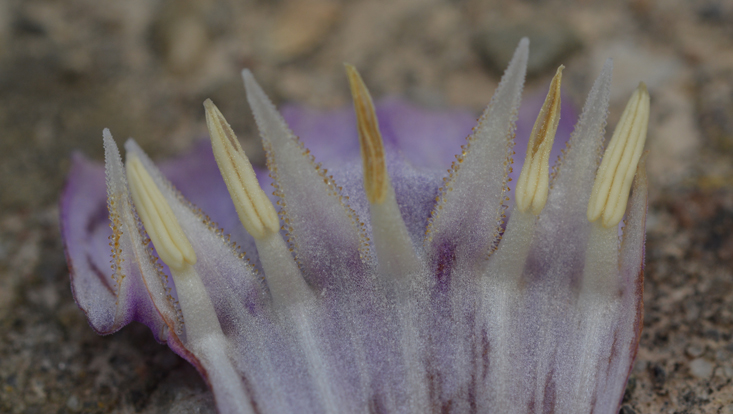
Photo: UHH/Rohwer
Photo of a longitudinally opened corolla of Symphytum officinale (Boraginaceae), with faucal scales alternating with stamens
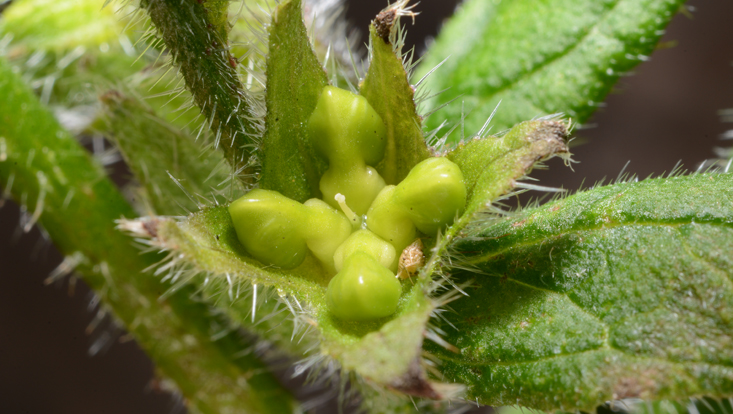
Photo: UHH/Rohwer
Immature fruit (schizocarp) of Pentaglottis sempervirens (Boraginaceae)
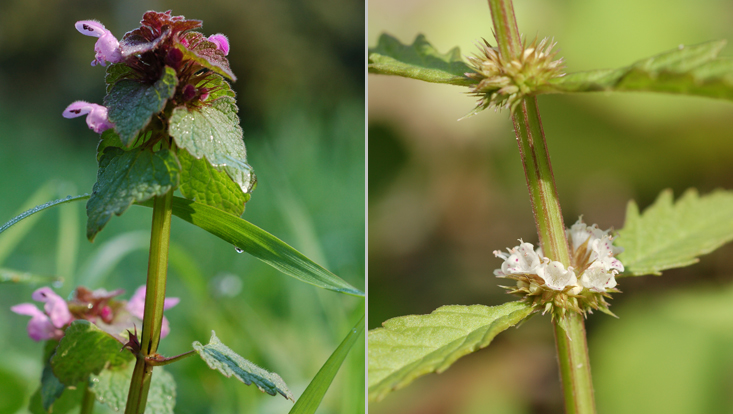
Photo: UHH/Rohwer
Photos of the characteristic vegetative characters of Lamiaceae: quadrangular stems and opposite leaves, in Lamium purpureum (left) und Lycopus europaeus (right)
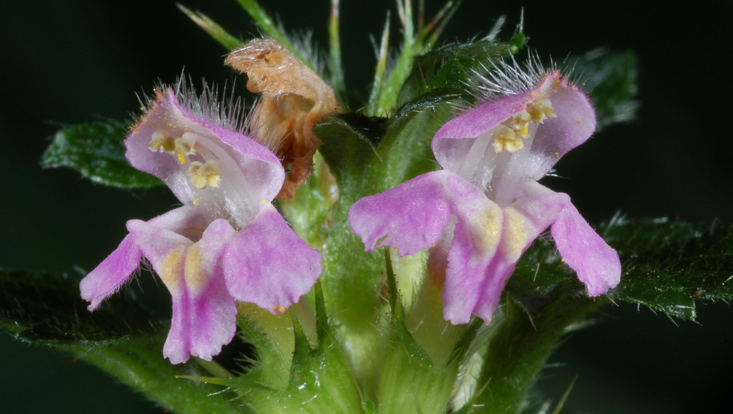
Photo: UHH/Rohwer
Typical zygomorphic Lamiaceae flowers in Galeopsis bifida
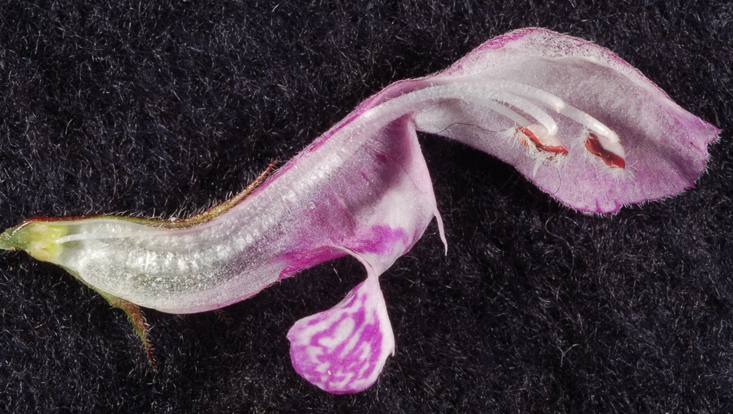
Photo: UHH/Rohwer
Longitudinal section of a flower of Lamium maculatum (Lamiaceae)
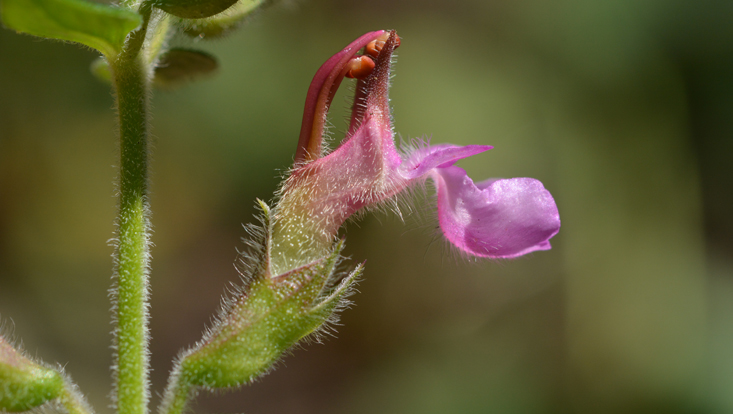
Photo: UHH/Rohwer
Flower of Teucrium chamaedrys (Lamiaceae)
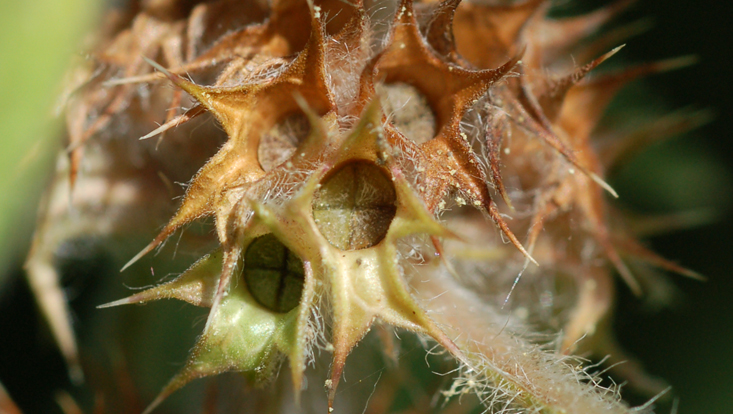
Photo: UHH/Rohwer
Calyces of Leonurus cardiaca (Lamiaceae), with almost mature fruits
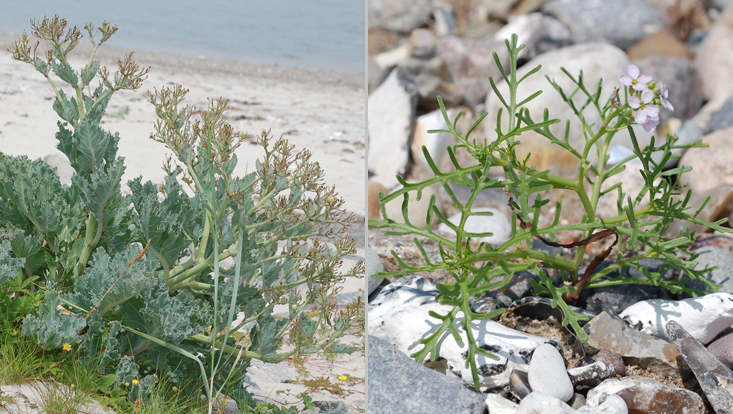
Photo: UHH/Rohwer
Halophytic Brassicaceae on the shore of the Baltic sea: Crambe maritima (left); Cakile maritima (right)
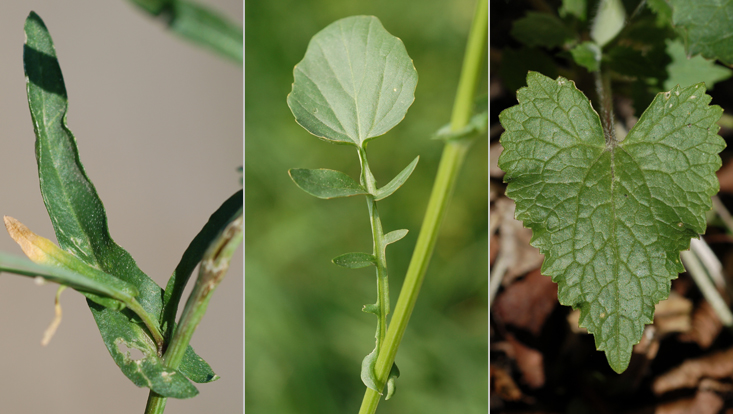
Photo: UHH/Rohwer
Leaves in Brassicaceae: Capsella bursa-pastoris (left), undivided, sessile, amplexicaul; Barbarea vulgaris (center), pinnatifid, sessile, auriculate; Lunaria annua (right), cordate, petiolate
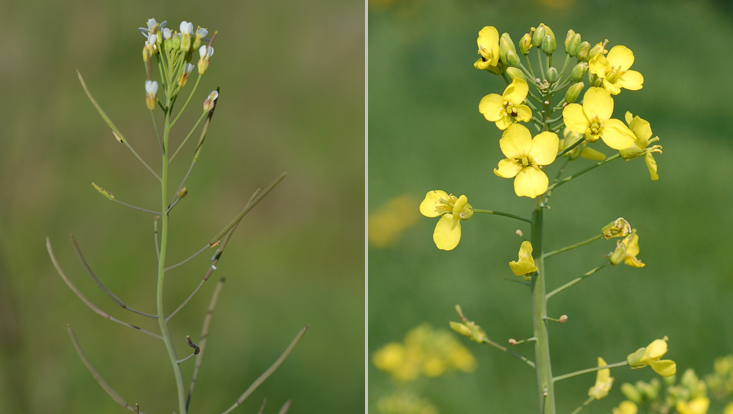
Photo: UHH/Rohwer
The typical inflorescence in Brassicaceae: ebracteate racemes, in Arabidopsis thaliana (left) and Brassica napus (right)
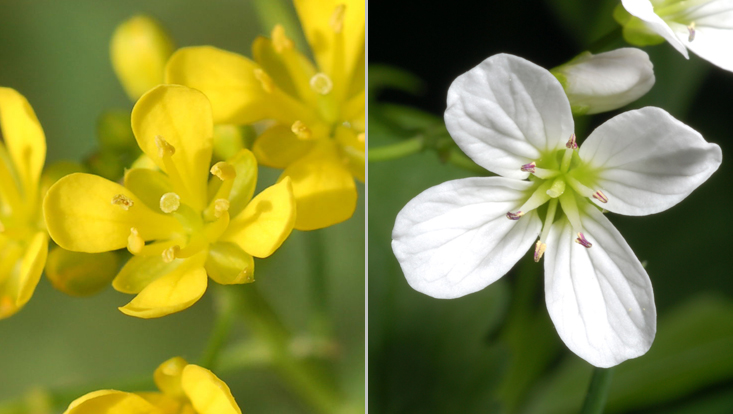
Photo: UHH/Rohwer
The typical flower construction in Brassicaceae, K4 C4 A2+4 G(2): Rorippa sylvestris (left); Cardamine amara (right)
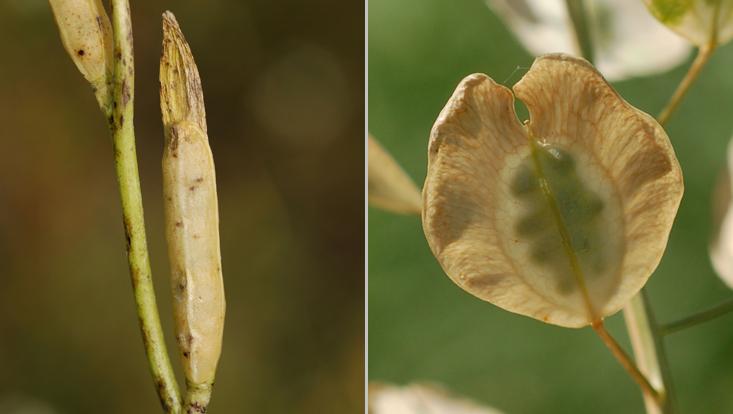
Photo: UHH/Rohwer
Fruits in Brassicaceae: beaked silique in Eruca sativa (left); silicle in Thlaspi arvense (right)
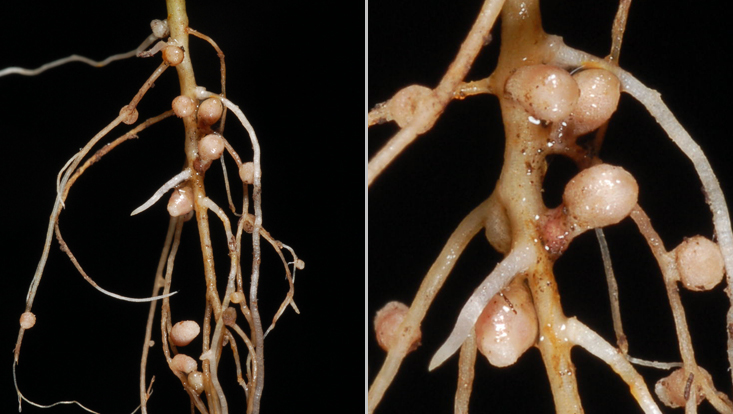
Photo: UHH/Rohwer
Roots of Trifolium dubium (Fabaceae), with nodules
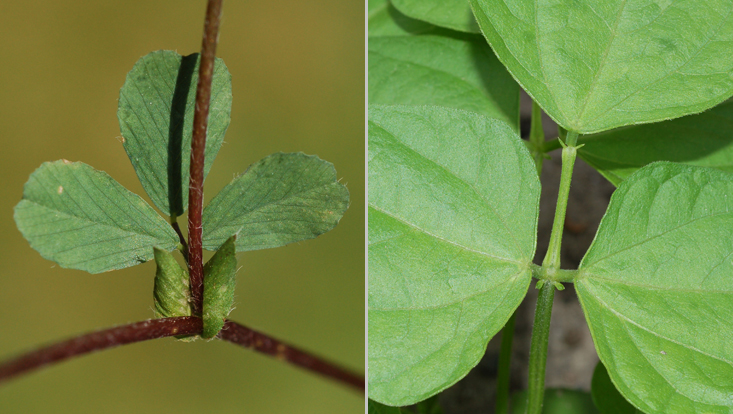
Photo: UHH/Rohwer
Fabaceae leaves: Trifolium dubium (left), with stipules at the base of the petiole; Phaseolus vulgaris (right), with stipellules at the bases of the petiolules
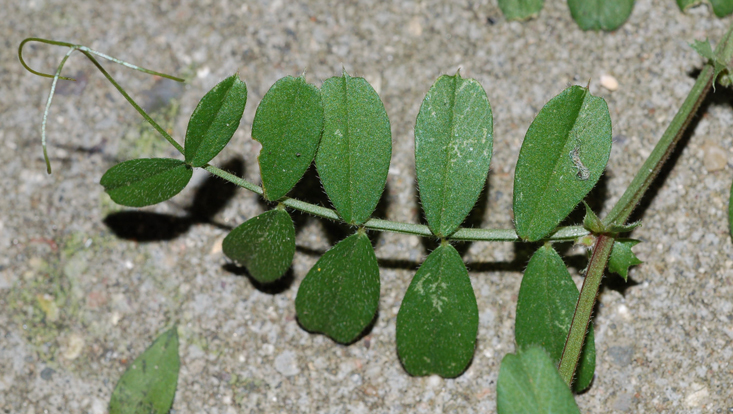
Photo: UHH/Rohwer
Pinnate leaf of Vicia sativa (Fabaceae), with tendrils derived from leaflets
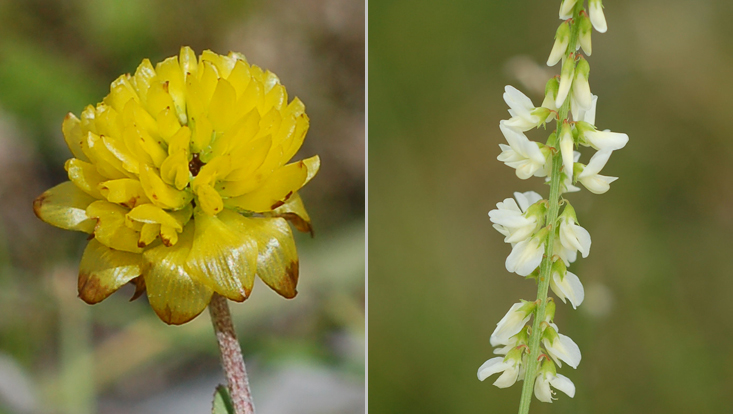
Photo: UHH/Rohwer
Inflorescences of Fabaceae: almost capitulate in Trifolium badium (left); raceme in Melilotus albus (right)
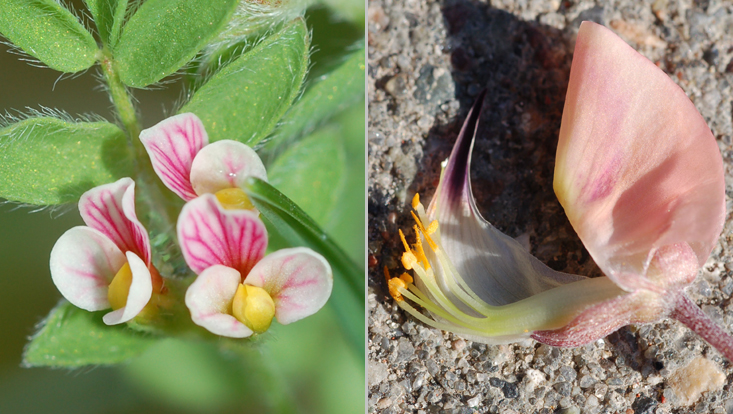
Photo: UHH/Rohwer
Flowers of Fabaceae: Ornithopus perpusillus (left), with red-veined banner, paler wings and yellow keel; Lupinus polyphyllus (right), wings and half of the keel removed, showing the filament tube
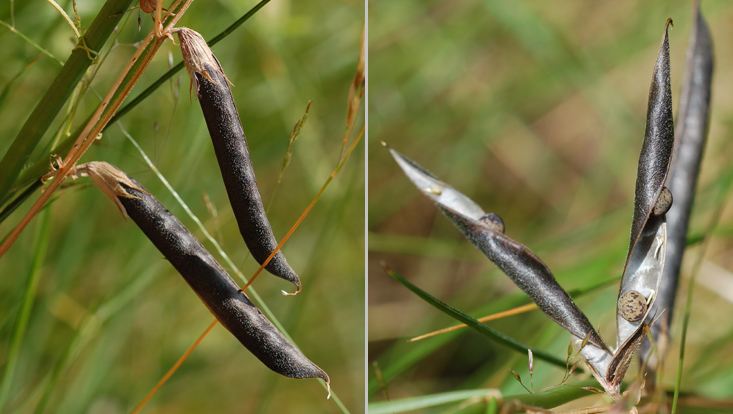
Photo: UHH/Rohwer
Legumes of Vicia sativa (Fabaceae): still closed (left); dehisced (right)
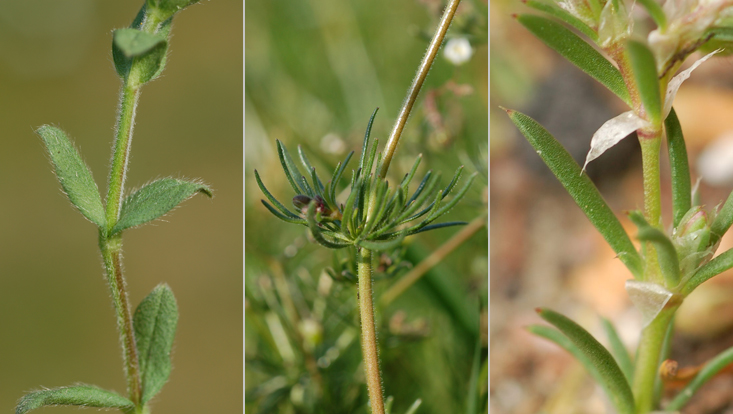
Photo: UHH/Rohwer
Leaves in Caryophyllaceae: Cerastium fontanum (left), opposite, sessile, without stipules and apparently 1-nerved, the most common pattern in Caryophyllaceae; Spergula arvensis (center), pseudo-verticillate; Spergularia rubra (right), with membraneous interpetiolar stipules
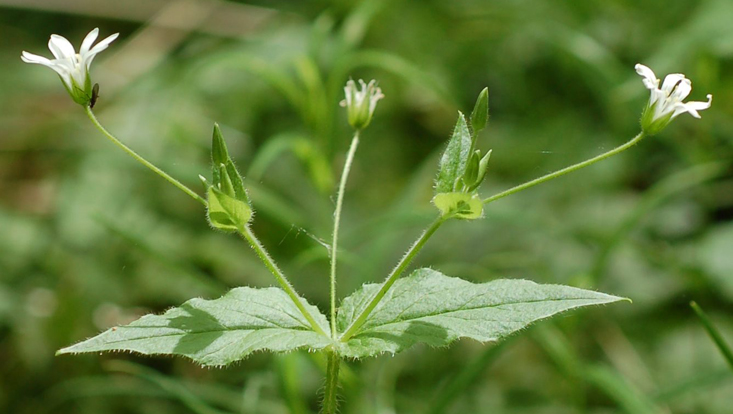
Photo: UHH/Rohwer
Dichasial inflorescence of Stellaria aquatica (Caryophyllaceae)
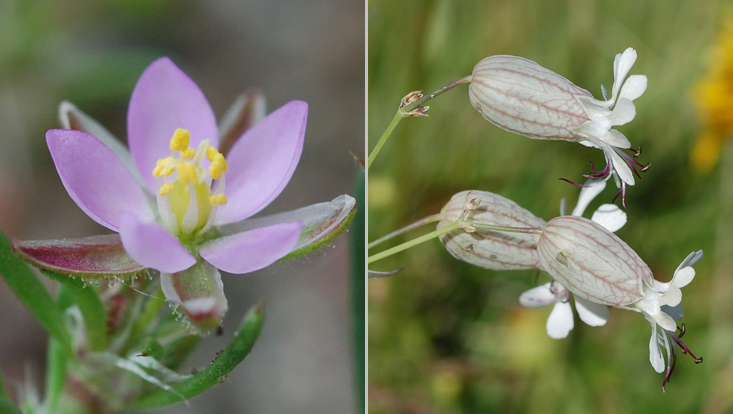
Photo: UHH/Rohwer
Caryophyllaceae flowers: Spergularia rubra (left), with free sepals; Silene vulgaris (right), with fused sepals
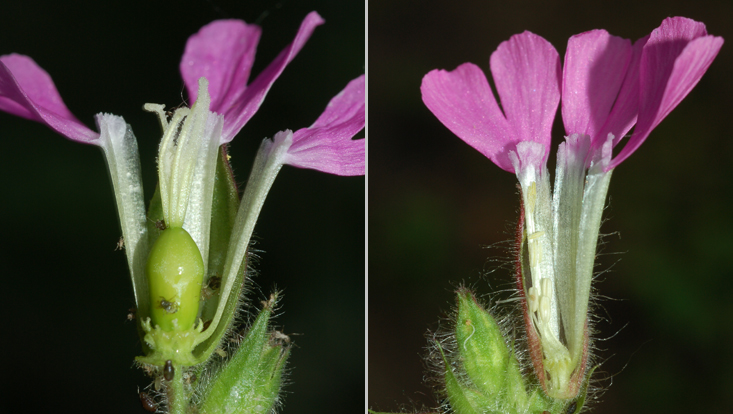
Photo: UHH/Rohwer
Flowers of Silene dioica (Caryophyllaceae), opened longitudinally: female (left) and male (right)
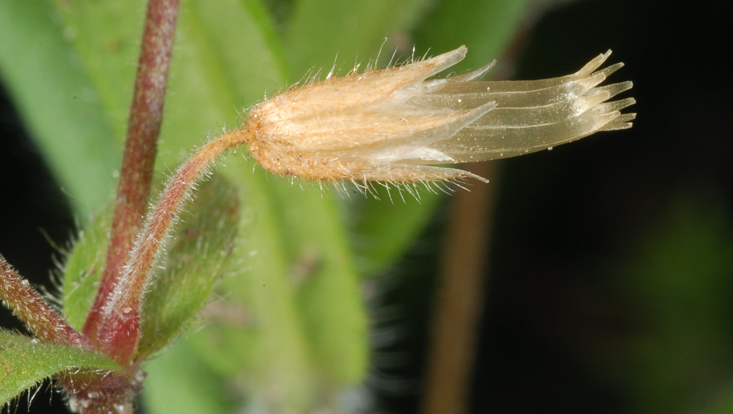
Photo: UHH/Rohwer
Photo of a capsule of Cerastium fontanum (Caryophyllaceae), opening by teeth
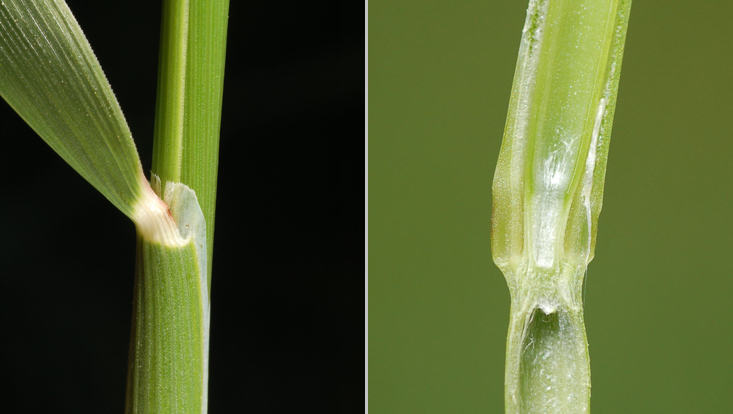
Photo: UHH/Rohwer
Alopecurus pratensis (Poaceae): upper end of leaf sheath, with ligule (left); longitudinal section of culm, with solid node (right)
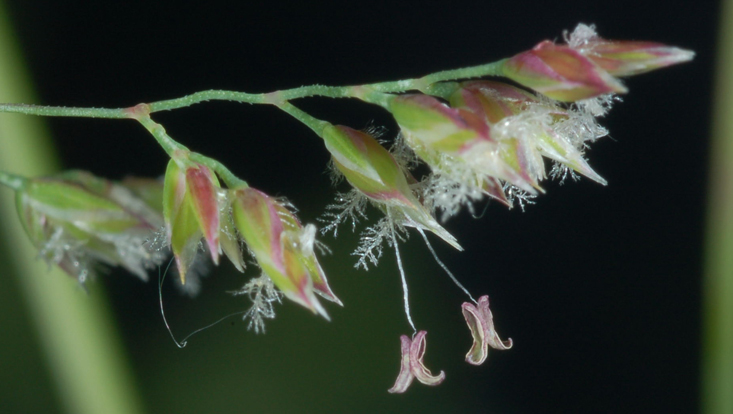
Photo: UHH/Rohwer
Panicle branch of Poa pratensis (Poaceae), with flowering spikelets
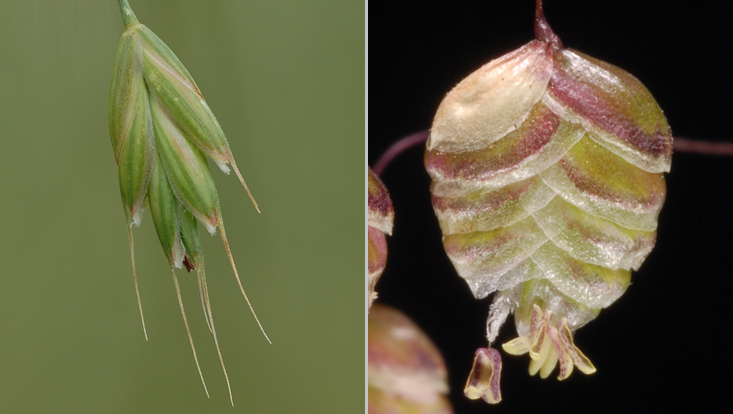
Photo: UHH/Rohwer
Poaceae spikelets: Bromus secalinus (left), lemmae with awns; Briza media (right), without awns
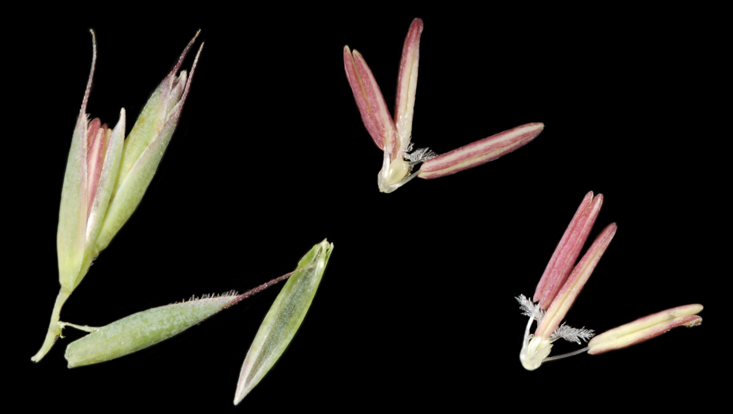
Photo: UHH/Rohwer
Spikelet and flower parts of Festuca rubra (Poaceae): on the left three closed flowers, a lemma (with awn) and a palea (without awn) removed; in the center and on the right two flowers without their floral bracts
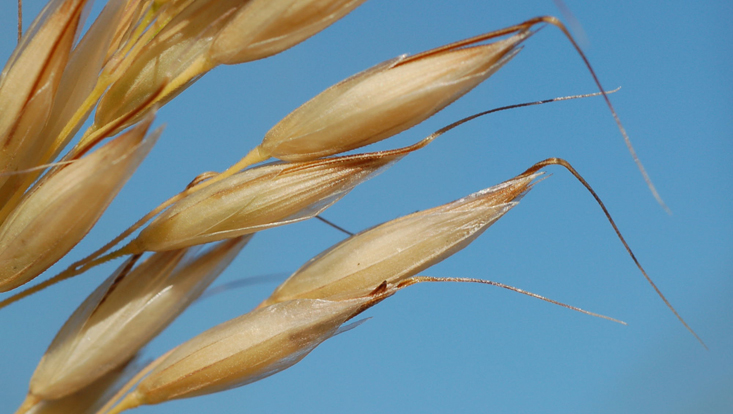
Photo: UHH/Rohwer
Fruiting spikelets of Arrhenatherum elatius (Poaceae), with bent awns
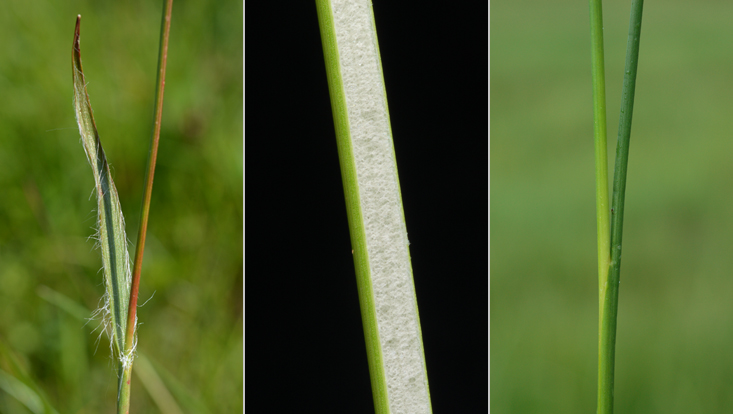
Photo: UHH/Rohwer
Stems and leaves of Juncaceae: Luzula campestris (left), with pubescent leaf sheath; Juncus effusus (center), longitudinal section of leaf; Juncus articulatus (right)
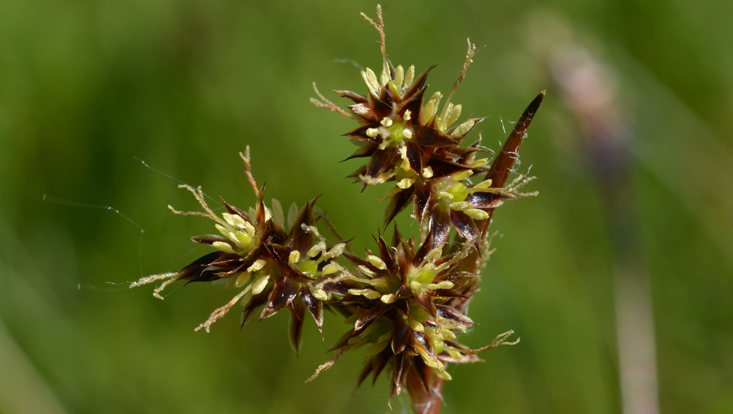
Photo: UHH/Rohwer
Inflorescence of Luzula campestris (Juncaceae)
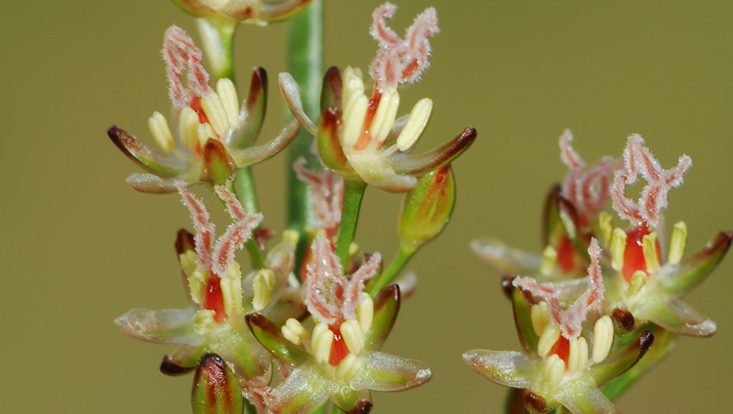
Photo: UHH/Rohwer
Flowers of Juncus tenuis (Juncaceae)
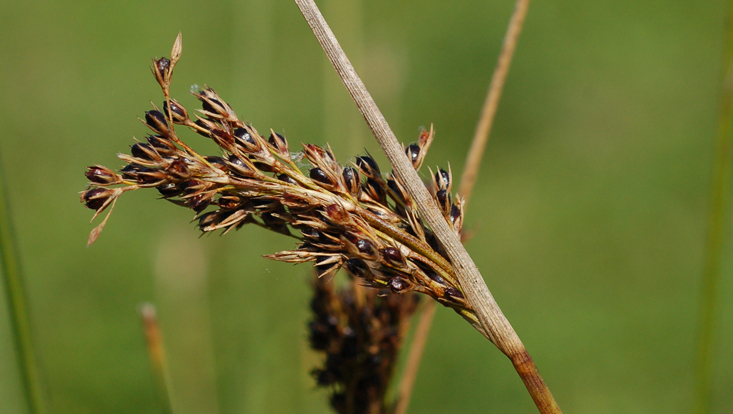
Photo: UHH/Rohwer
Infructescence of Juncus inflexus (Juncaceae)
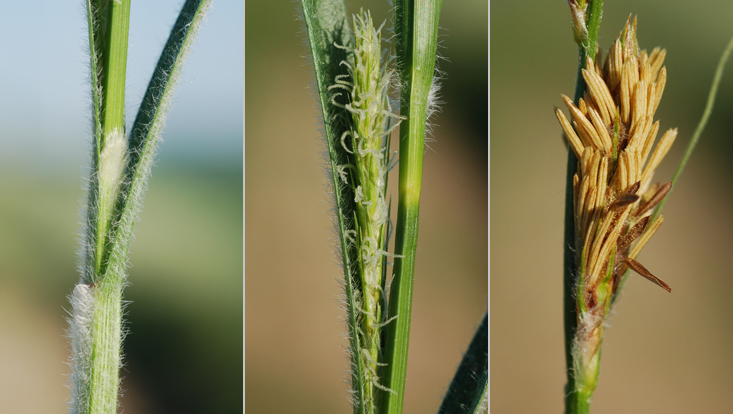
Photo: UHH/Rohwer
Details of Carex hirta (Cyperaceae): stem with leaf sheaths (left); pistillate flowering spike (center); staminate flowering spike (right)
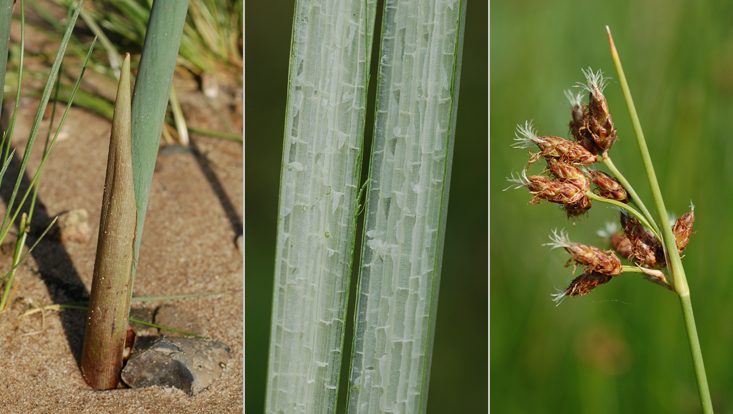
Photo: UHH/Rohwer
Photos of Schoenoplectus lacustris (Cyperaceae): base of shoot (left); longitudinally cut shoot (center); tip of shoot with flowering spikelets (right)
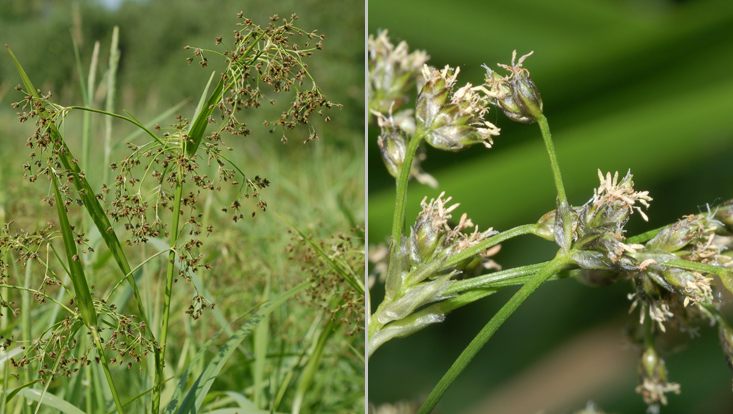
Photo: UHH/Rohwer
Scirpus silvaticus (Cyperaceae): entire inflorescence (left) and detail (right)
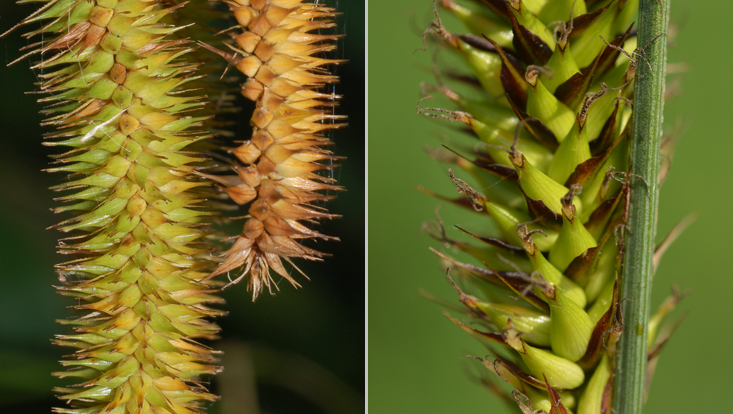
Photo: UHH/Rohwer
Fruiting spikes of Carex (Cyperaceae): C. pseudocyperus (left); C. riparia (right)
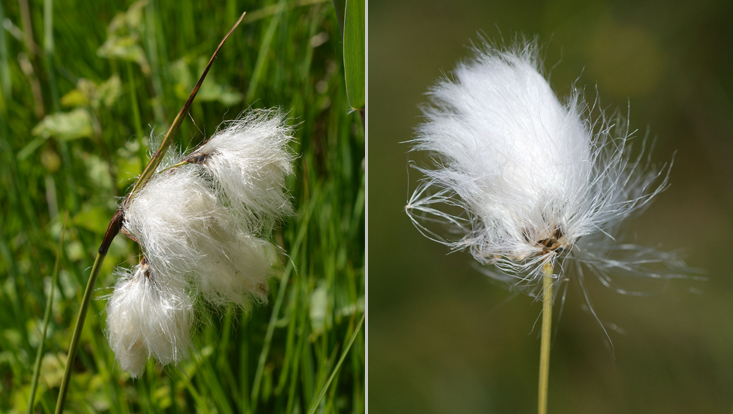
Photo: UHH/Rohwer
Infructescences of Eriophorum (Cyperaceae): E. angustifolium (left); E. vaginatum (right)
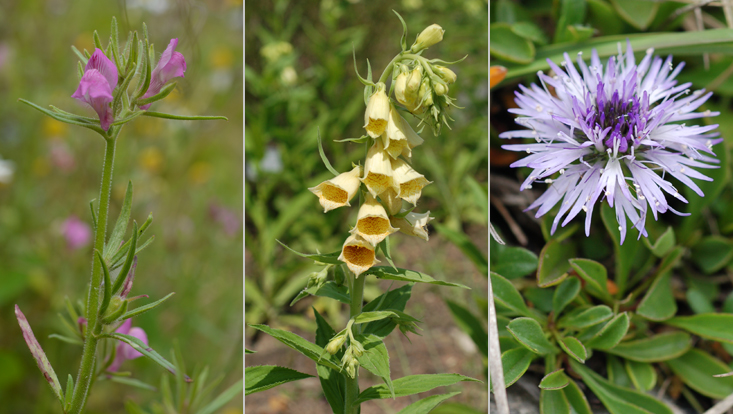
Photo: UHH/Rohwer
Flowering Plantaginaceae: Misopates orontium (left); Digitalis grandiflora (center); Globularia cordifolia (right)
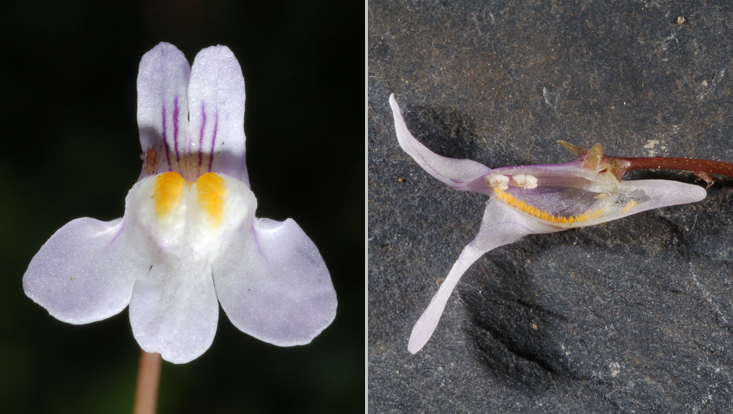
Photo: UHH/Rohwer
Flower of Cymbalaria muralis: frontal view (left) and longitudinal section (right)
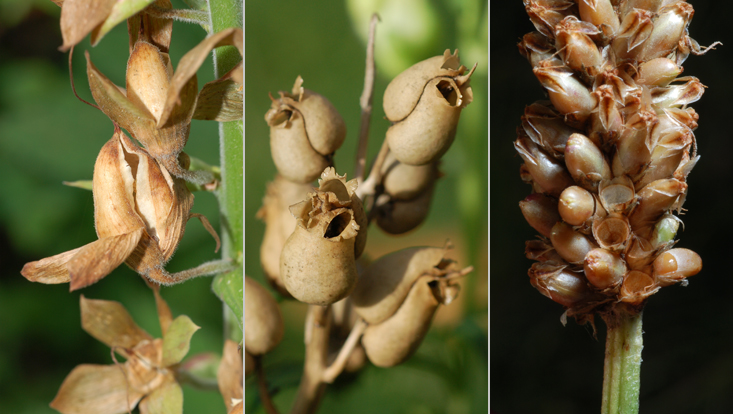
Photo: UHH/Rohwer
Fruits of Plantaginaceae: septicidal capsules in Digitalis purpurea (left), poricidal capsules in Antirrhinum majus (center), operculate capsules in Plantago lanceolata (right)
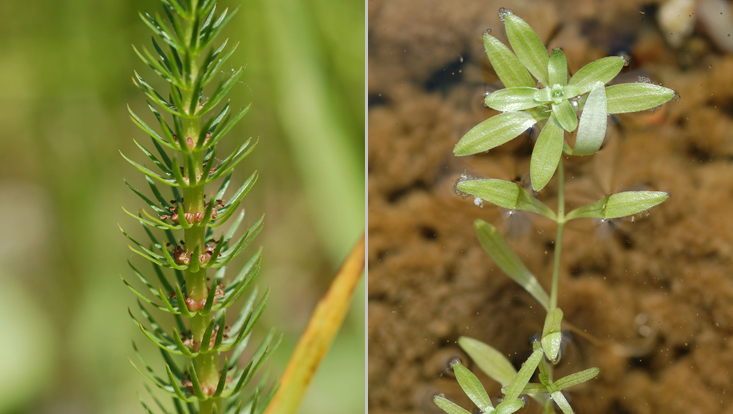
Photo: UHH/Rohwer
Aquatic plants in the Plantaginaceae: Hippuris vulgaris (left), Callitriche spec. (right)
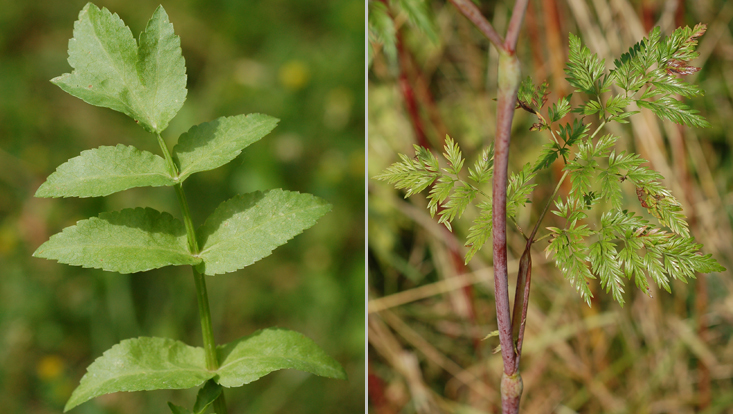
Photo: UHH/Rohwer
Leaves of Apiaceae: Helosciadium nodiflorum (left), simply pinnate; Chaerophyllum bulbosum (right), multiply pinnate
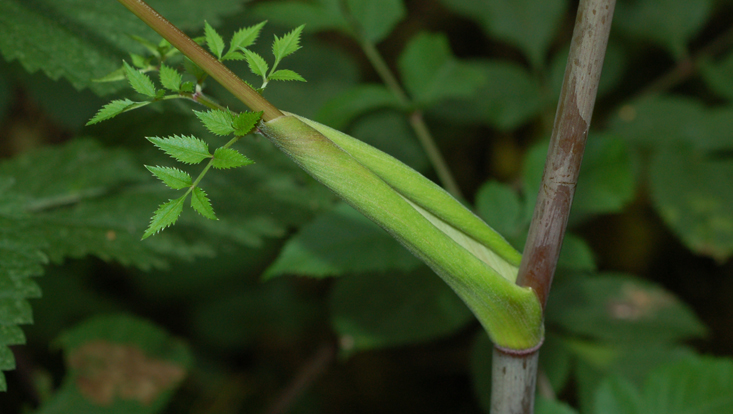
Photo: UHH/Rohwer
Upper stem leaf of Angelica sylvestris (Apiaceae), with big leaf sheath
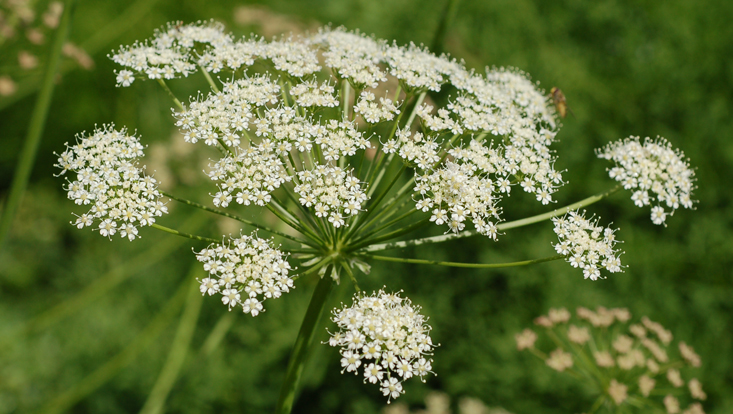
Photo: UHH/Rohwer
The typical compound umbel of Apiaceae (Laserpitium siler)
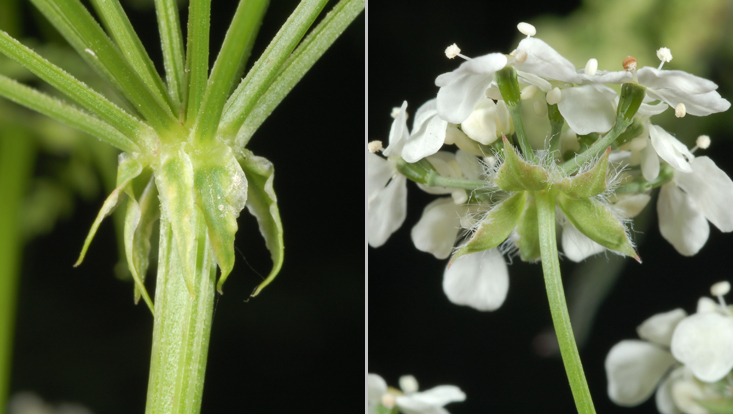
Photo: UHH/Rohwer
Details of Apiaceae inflorescences: first-order branching of the umbel in Conium maculatum (left), with involucral bracts; second-order branching = umbellule of Anthriscus sylvestris (right), with involucels
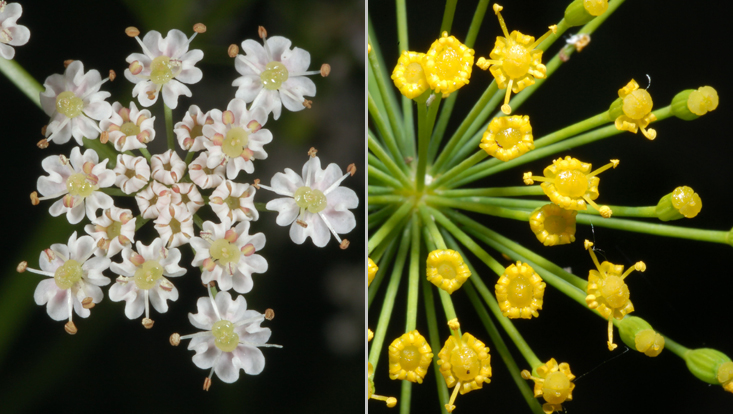
Photo: UHH/Rohwer
Flowers of Apiaceae: Caraway (Carum carvi, left); Dill (Anethum graveolens, right)
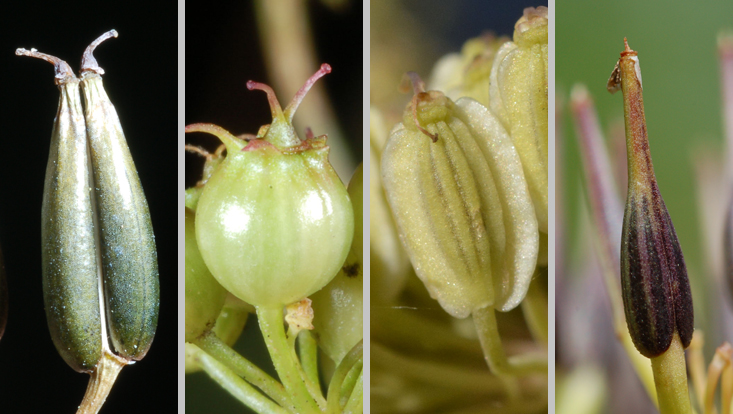
Photo: UHH/Rohwer
Fruits of Apiaceae, from left to right: Anthriscus sylvestris, Carum carvi, Angelica sylvestris, Scandix pecten-veneris
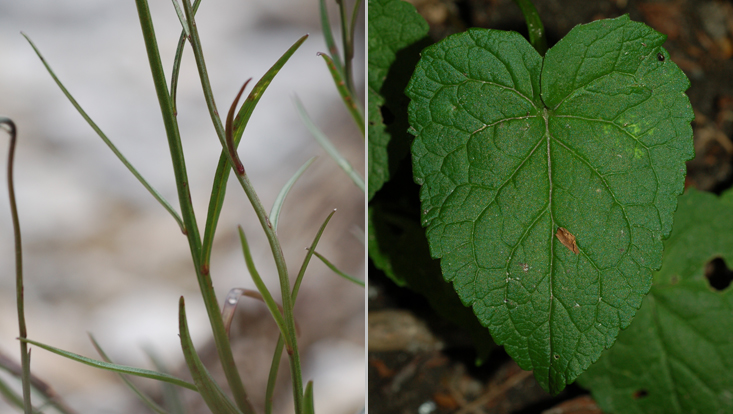
Photo: UHH/Rohwer
Leaves in Campanulaceae: almost linear in Campanula rotundifolia (left – the epithet rotundifolia refers to the basal rosett leaves only); cordate in Phyteuma spicatum (right)
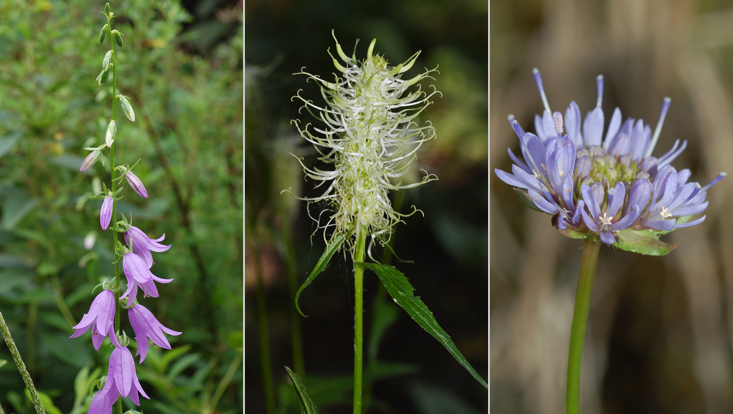
Photo: UHH/Rohwer
Inflorescences in Campanulaceae: raceme in Campanula rapunculoides (left); spike in Phyteuma spicatum (center); head-like umbel in Jasione montana (right)
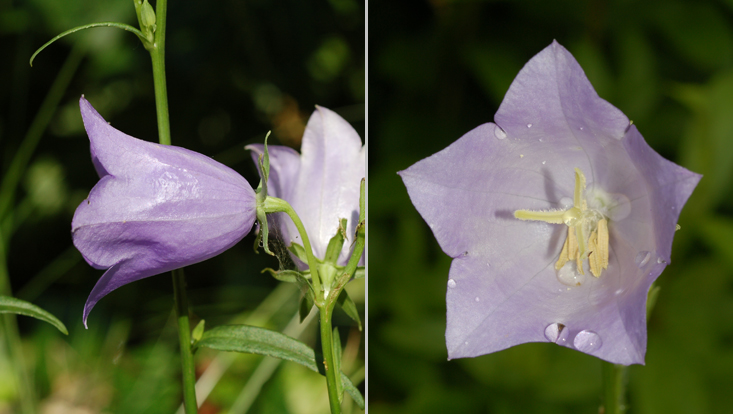
Photo: UHH/Rohwer
Flowers of Campanula persicifolia; lateral view (left) and frontal view (right); stamens already wilted before opening of the flower
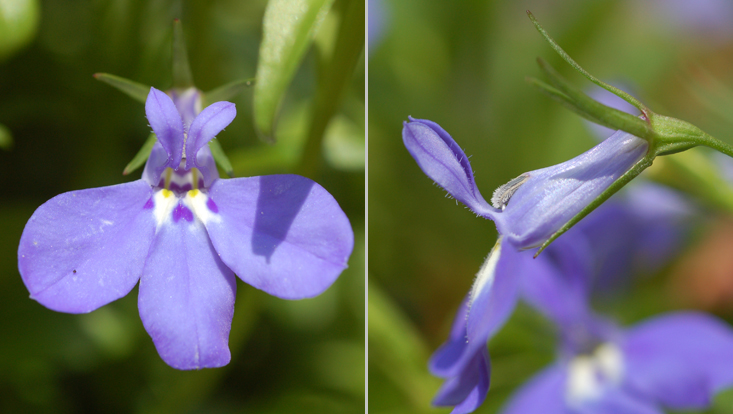
Photo: UHH/Rohwer
Flower of Lobelia erinus, frontal and lateral view
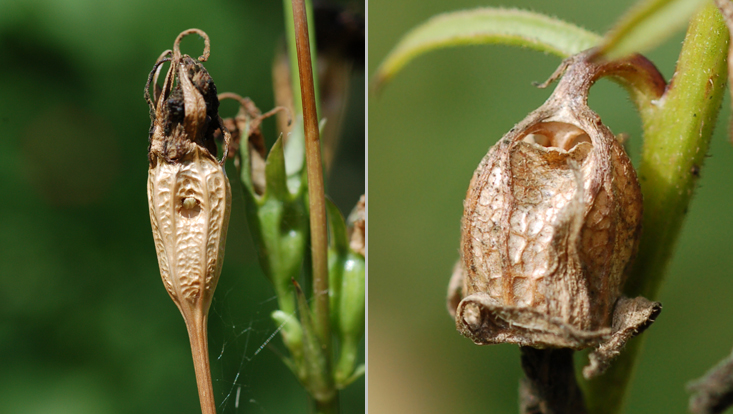
Photo: UHH/Rohwer
Capsules in Campanulaceae: Campanula persicifolia (left), with distal pores in upright capsules; C. rapunculoides (right), with proximal pores in pendent capsules
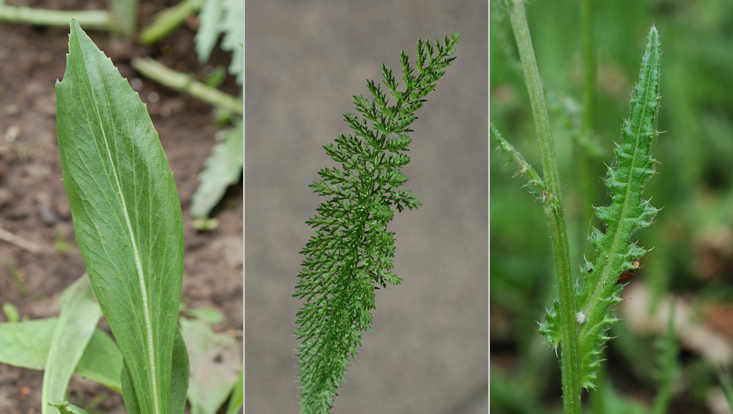
Photo: UHH/Rohwer
Leaves of Asteraceae: Scorzonera hispanica (left); Achillea millefolium (center); Cirsium dissectum (right)
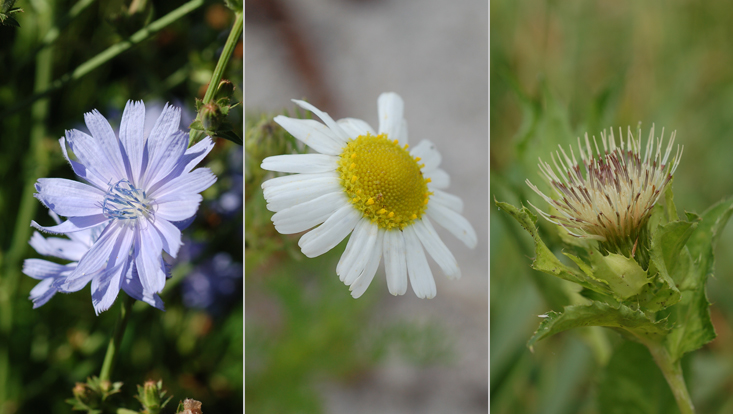
Photo: UHH/Rohwer
Capitula of Asteraceae: Cichorium intybus (left), with ray florets only; Tripleurospermum maritimum (center), with ray florets and disk florets; Cirsium oleraceum (right), with disk florets only
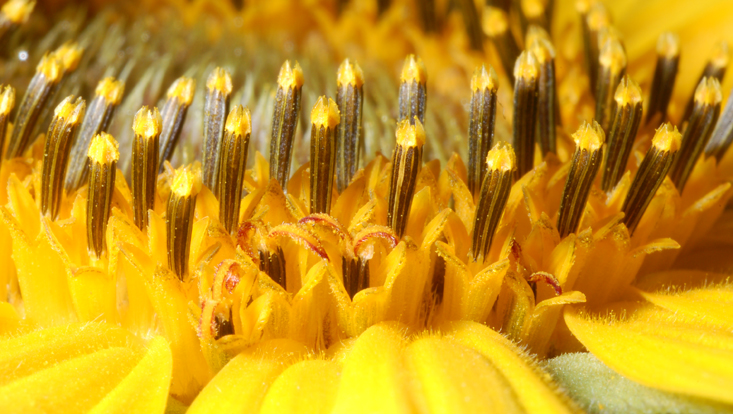
Photo: UHH/Rohwer
Closeup of the rim of a capitulum of Helianthus annuus (Asteraceae); spreading stigma branches visible in some florets in the foreground
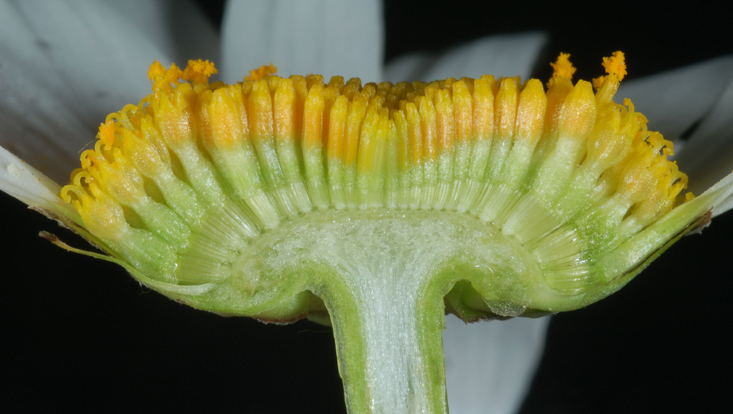
Photo: UHH/Rohwer
Longitudinal section of a capitulum of Leucanthemum vulgare (Asteraceae)
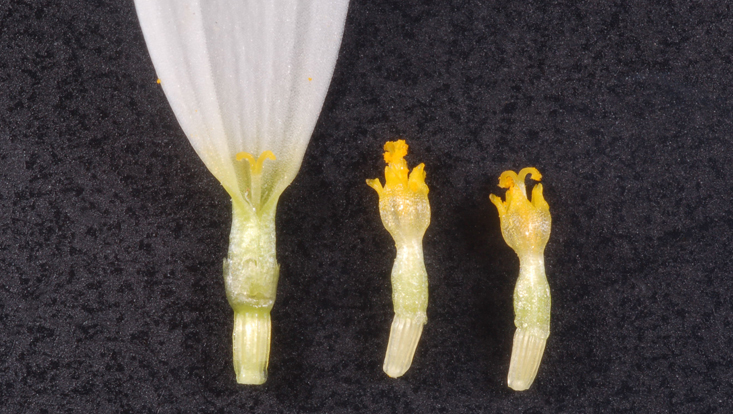
Photo: UHH/Rohwer
Florets of Leucanthemum vulgare: ray floret(left) and two disk florets, in male phase (center) and in female phase (right)
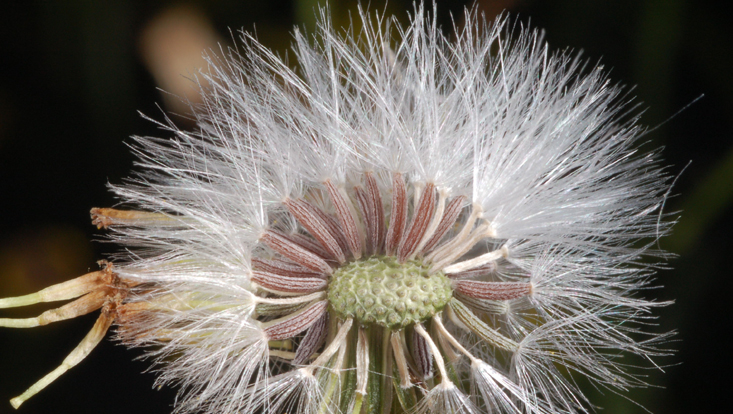
Photo: UHH/Rohwer
Fruiting capitulum of Senecio inaequidens (Asteraceae)
Biology for Students of Geosciences
- Contact: Kai Jensen( Kai.Jensen"AT"uni-hamburg.de) (Applied Plant Ecology)
- Target group: BSc students of geosciences, 1st. sem.
61-910 Biology for Students of Geosciences (lecture)

Photo: UHH/Rohwer
additional images in preparation ...
61-911 Biology Course for Students of Geosciences (practical course)

Photo: UHH/Rohwer
additional images in preparation ...
